Better Sailing


Sailboat Vs Yacht: What is The Difference?
Many boaters use the terms “sailboat” and “yacht” interchangeably when they are actually quite distinct. A yacht is a larger boat or ship that is used for recreational purposes. The term “yacht” is of Dutch origin, and it was initially described as a small, swift sailing vessel used by the Dutch navy to track down and catch pirates. A boat, on the other hand, is a smaller vessel that can range from a fishing boat to a sailboat in size. So, if you’re interested in this topic, this article will compare yachting with sailing in many ways. Like this, you will have a much better understanding of which option is best for you. Keep reading!
Sailboats and Yachts: Meaning
Firstly, it’s important to understand the meaning of each word. Generally, a boat is a form of watercraft that comes in a variety of shapes and sizes. A boat is a watercraft that is small enough to fit on a ship, which is typically less than 1,000 feet long. A ship is a huge vessel with a large carrying capacity that can transport other vessels. The size, shape, and capacity of a boat vary depending on its intended usage. Boats are most commonly employed for navigating places along the water’s edge or inland waterways like lakes and rivers, although they can be utilized on any water source. Boats can be used for a variety of purposes, including providing service to people and vessels on the water, recreational activities, commercial passenger, and cargo transportation across waterways.
So, a sailboat (sailing vessel) is a boat that is propelled primarily by the force of the wind on sails. Keep in mind that the term “boat” can cause some misconceptions about the vessel’s size. People may refer to it as a sailing ship rather than a sailing boat once it reaches a particular size. Also, boats are generally thought to be smaller than ships. A sailboat is a water-borne watercraft whose principal means of propulsion is the wind, which is captured and controlled by triangular-shaped pieces of cloth known as ‘sails.’ On the other hand, a powerboat is a watercraft with an internal combustion engine as its primary source of propulsion.
A yacht is most likely a vessel that is primarily used for personal rather than business purposes. There are yachts that you can hire for a week or more. This might add a little confusion as they are commercially owned but within the hire period, they are used by individuals for leisure purposes. Generally, people usually refer to sailboats as yachts or vice-versa. This is a common phenomenon nowadays, however, there are significantly more sailing yachts than motor yachts at the seaside/marina. If you want to specify a boat that is not largely powered by the wind, use the word motor yacht.
Sailing yachts and motor-powered yachts are the two forms of yachts available today. Yachts range in length from 26 feet to hundreds of feet. A cabin cruiser, or just a cruiser, is a luxury vessel that is less than 39 feet long. A superyacht is typically above 70 feet long. So, what is the definition of a mega yacht? They usually exceed 150 feet in length, but there is no top limit! Note that the world’s largest boat is 728 feet long, or 222 meters.
Let’s now check the main differences between a sailboat and a yacht:
Sails and Motor
The boat may be powered purely by the wind or by one or more inboard or outboard motors, depending on the model. While some larger boats may have very massive engines to provide genuine speed on the water, most yacht engines are far less powerful. Yacht engines are substantially larger, can produce far more power – up to 800hp in some circumstances – and can go many further distances.
If you’re searching for a vessel that’s easier to operate, you could argue that a yacht is a superior option. Sure, the computer components are more complicated, and there is more to manage, but sailing will be simpler. In stormy weather, managing a sail can be tricky. From inside the cabin, you can’t manage your sails. You may, however, operate your yacht from the cabin.
It’s a fact that sailboats will always have sails. After all, it’s their primary source of propulsion. The nail is what propels the boat forward by harnessing the wind. So long as the weather permits, sailing can be done anywhere, at any time. Yachting, on the other hand, has its own set of restrictions. A yacht will usually lack a sail, which can be viewed as a good or negative aspect, depending on your perspective.
The advantage of having a sail over only an engine is that you don’t have to worry about running out of fuel. Fuel is not only costly but also inconvenient and pollutes the environment. When on long voyages, you must always keep an eye on your fuel levels, or you risk breaking down at sea. The great thing with sailboats is that as long as there is wind, a sailboat can sail. If you have an extra sail onboard, you should be alright regardless of what occurs. You have a significantly lower chance of being left stranded at sea.
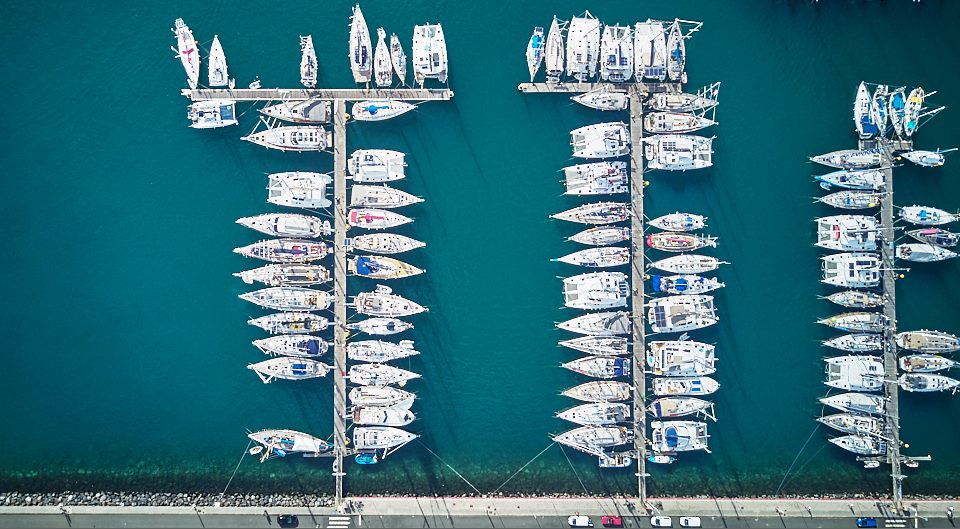
>>Also Read: Sailboats Vs Powerboats: Why Sailboats are Better
Size Matters
The size difference between a yacht and a sailboat is one of the most significant ones. Most of the time, a sailboat will almost certainly be smaller than a yacht. Of course, some sailboats are larger than others, but if we’re talking about average sizes, a yacht will be larger. The reason that size counts so much when deciding which boat to buy is that the available space is limited. So, if you opt for space note that the larger your boat is, the more space you’ll have. This may seem self-evident, but it is one of the most crucial aspects of your boat to which many people forget to give due consideration.
Generally, when it comes to boats, size will always matter. Except in cases where someone prefers overall better performance and speed. But, keep in mind that almost everything you do will be influenced by the size of your boat. The smaller the boat, the less storage space you have, the less space you have for emergency supplies, and even the less space you have for yourself. Regardless of the size of your boat, your sleeping quarters will most certainly be small. Also, depending on your height, every inch of a room may be crucial.
When there are more people on your boat than just you, size matters the most. If you intend to live alone on your yacht, you will have a significant space advantage. If there are three persons on board, you probably going to need more equipment and devices for cooking or for emergencies. All of this suggests that the sleeping space is the most significant distinction between living alone and living with people. If you live alone on a yacht that can sleep four people in theory, you will have a lot more storage and consequently space.
People on Board
The extent to which the crew will influence your decision is mostly determined by your budget and the size of the vessel you are considering buying. Meaning that if you’re intending to buy a sailboat, you won’t need any crew. Except for your family/friends that live on your boat with you, you basically are the entire crew. However, if you own a yacht, it’s an entirely different scenario.
If you intend to live aboard your yacht, you may require the assistance of one or two crew members. There will be plenty to do even if you are the most essential member of the team, i.e. the captain. This is because you might haven’t already mastered things like navigation, maintenance, plumbing, and engineering. So, a yacht often requires a complete crew to assist with navigation, maintenance, electronics and engineering, repairs, and sometimes even stewards to attend to the passengers.
In other words, having a sailboat means that you can take care of everything yourself. There are only a few computer components that will need to be repaired, and you are unlikely to have an engine. Repairing a sailboat isn’t easy in and of itself; it’s just easier for one person to handle. Meaning that it’s far easier to replace a sail than it is to fix an engine. In bad weather, a small sailboat is just easier to monitor than a large yacht. At the absolute least, another set of eyes will be probably required when sailing with a yacht.
Price also Matters
In general, yachts tend to be more expensive than sailboats. Occasionally, a great deal more. For a variety of factors, the most important of which are materials, design, and construction techniques. Note also that a boat’s price is likely to rise as it becomes more modern. Although this isn’t always the case, it is the vast majority of the time. If money is a key factor in deciding which boat to buy, here’s something to think about: just because a yacht is more expensive doesn’t mean you shouldn’t have one. If you have the cash, knowledge, and you know the kind of sailing you will be doing then go for a yacht!
Note also that a sailboat can be outfitted with a variety of amenities and conveniences. But, the sailboat doesn’t always include these features. This will mostly depend on the type of sailboat. As a result, buying a basic sailboat can save you a lot of money. However, most yachts will provide high end amenities. As a result, a motor yacht will cost significantly more than a regular sailboat. Sailboats are also smaller than yachts, which means you have a larger selection of less expensive boats to pick from when making your purchase. But, yachts often start in the six-figure range and can reach millions of dollars depending on the yacht’s size, age, and build quality.
Maintenance and Repairs
Yachts are frequently more expensive to maintain than sailboats. Meaning that boat engines require a great deal of upkeep, and the expense of fuel can be prohibitive for many individuals. For example, did you know that a gallon of diesel fuel in a yacht may only allow you to travel less than 1 nautical mile? If you’re going on a long voyage out to the sea, you can end up spending a lot of money on fuel. A sailboat, on the other hand, can take you wherever you want to go with very little fuel. Bear in mind also that a yacht’s insurance is more expensive than that of a sailboat. One of the main reasons is because it is classified as a yacht.
In addition to the boat’s price there are some other things to consider. The most important one is maintenance and repairs. A boat will always need these and it might need them once per month or once per year. It depends on the kind of repairs and on the way in which you “treat” your boat. Also, if you’re buying a used sailboat, you will need sometimes more research and more money for upgrades. It will be repainted, restored, and upgraded, although it will remain the same size. You should approach buying a boat in the same way that you would with a car. So, according to the size and kind of boat you want to buy, it’s important to keep in mind the price and extra costs as well.
While advanced marine electronics and navigation systems are available on some boats, they are more of a must for yachts. When doing transatlantic voyages, it is critical not only to be able to navigate with precision but also to be able to identify other boats or objects that you may not be able to see, as well as to comprehend your vessel’s performance.
When it comes to technology, it’s not just about whether you’re choosing a sailboat or a yacht. The age of the specific vessel is also something to consider. A sailboat that is more than ten years old may not be as technologically advanced as a brand new sailboat. Better technology can offer a lot of opportunities for you if you decide to buy a yacht. First and foremost, it can make working on your boat much more convenient. There’s no reason you couldn’t work remotely from your boat if you have the ability to set up a functional office with wifi.
Technology also brings up a lot of new possibilities for you when it comes to the act of sailing. A sailboat could traverse the Pacific or Atlantic, but it would be rather difficult. On the other hand, with a yacht, it can be a lot easier. In comparison to a sailboat, your yacht will have advanced navigational systems, warning and guidance systems, and many more safety features.
Sea, Lakes, or Rivers?
Bear in mind that in shallow waters, large yachts are unable to sail. A sailboat is a way to go if you plan on sailing in areas with shallow waters. In the Caribbean, for example, a yacht might be difficult to navigate. At the very least, it’ll be more difficult than sailing. A yacht, on the other hand, may travel to far more places than a sailboat.
A small sailboat might theoretically sail across the Atlantic. However, it can be quite risky, and your boat might not be able to withstand the strong winds and waves. Furthermore, if you’re aboard a sailboat, you can be the only one on board. This means that if the worst happens, far out at sea, there will be no one to aid you. You can do it, of course, but it is risky.
So, smaller boats may normally operate in calmer seas such as lakes, rivers, and shallow harbors. Larger boats, usually between 20 and 30 feet long, can equally navigate rougher ocean seas. A yacht, on the other hand, can sail in deeper ocean waters and handle more choppy seas. Yachts are significantly more ideal for lengthy ocean voyages due to their bigger size, high-tech electronics and guidance equipment, weather protection, and a variety of other characteristics.
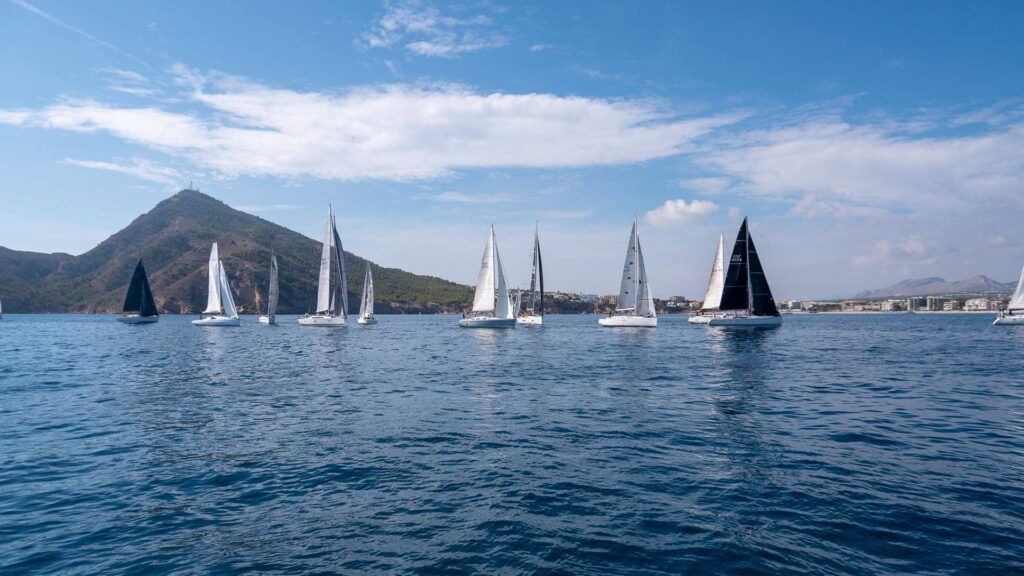
>>Also Read: Sailing Vs Boating: Why Sailing Is Better
Sailboat and Yatch Construction
Depending on the anticipated scale of production, sailboat makers can fabricate their own parts or order them. Masts, sails, engines, and metal fittings are common items provided by specialty vendors. Boatbuilders, on the other hand, create their own fiberglass hulls, using Gel coat polyester resin, a catalyst for the resin, woven fiberglass roving, and fiberglass. Wooden hull manufacturers create and shape their own wood in the same way. Note that the main building materials used in boat construction are aluminum, metal, wood, and fiberglass. The unique structure of each material offers a different design and usage as well as additional features to the way in which the boat is built.
Material considerations are important, whether they affect the cost or the durability of the product. Fiberglass, carbon fiber, and metals such as titanium will also be used to construct a boat. On the contrary, a sailboat will most likely be composed of wood or fiberglass. So, in case you value safety and sturdiness above all else, and money isn’t a big issue, a yacht will be significantly safer for you.
The material can also influence the way in which you make repairs. For instance, a wooden boat is much easier to repair than a metal boat. You can make some simple and quick repairs using wood, and they’ll probably last till you get to a marina. To do major repairs on a yacht, you’ll need a lot of specialized equipment and knowledge. Moreover, you may need to ask for a crew member to help you with this.
Sailboat Vs Yacht – Summary
As you can see there are many differences between a sailboat and a yacht. Nowadays many people tend to confuse or don’t be aware of the exact meaning and differences of these vessels, and it’s normal. But, we, as sailors, have to know the differences in order to understand which kind of boat is right for us. For example, if you want big spaces, luxury, or intend to liveaboard then you should opt for a yacht. But, if you want to experience the true joy of sailing, sail anywhere without worrying about polluting the environment or spending too much on fuel, then go for a sailboat! It will entirely depend on your needs and preferences so weigh the pros and cons of each one before making the decision.
In any case, I hope that you have now clarified the differences between these two and that you will make the right choice. I wish you all safe & enjoyable voyages!
Peter is the editor of Better Sailing. He has sailed for countless hours and has maintained his own boats and sailboats for years. After years of trial and error, he decided to start this website to share the knowledge.
Related Posts

Atlantic vs Pacific: Which is More Dangerous for Sailing?

The Ultimate Guide to Choosing the Best Fishing Line for Trolling

Lagoon Catamaran Review: Are Lagoon Catamarans Good?

Best Inboard Boat Engine Brands
- Buyer's Guide
- Destinations
- Maintenance
- Sailing Info
Hit enter to search or ESC to close.

My Cruiser Life Magazine
Yacht vs Sailboat – A Definitive Guide
What exactly is a yacht, anyway? Does it have to be a motor boat? But what about large sailing yachts?
The term is confusing because it is used differently in different places. Sometimes, it’s a term only reserved for large motor yachts with multiple crew member teams.
Here is a look at my observations. You might find that the lines are different in your harbor, but this article should get you started.
Table of Contents
- Sailboat vs Yacht – What’s the Difference?
Six Things that Make It a Yacht
So what’s a yachtie, then, sailing yacht vs motor yacht, types of yacht — what makes it a megayacht, modern yachts, classic designs.
- What about Yacht Racing?
Sailing Yachts or Motor Yachts
Faqs – motor and sailing yachts vs sailboats.
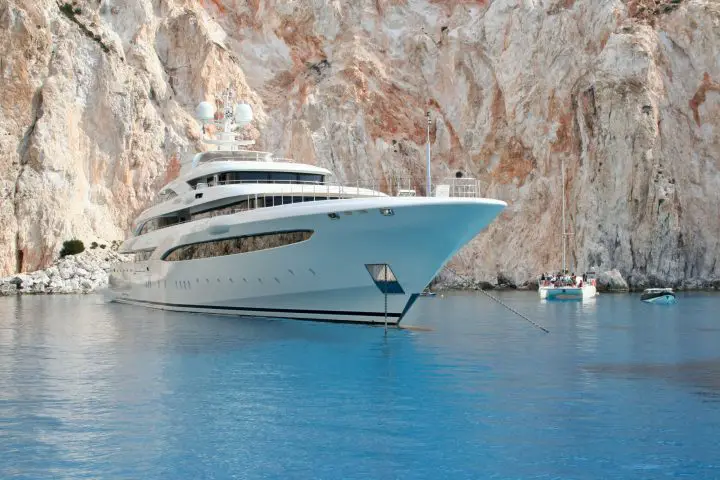
Sailboat vs Yacht – What’s the Difference?
Before diving in, it should be noted that there is some regional variation at play. For example, American and British sailors use the word yacht very differently.
First, the American definitions. From the Merriam-Webster dictionary, here are how sailboats compare to yachts.
Sailboat – A boat usually propelled by sail sailboat Boat – A small vessel for travel on water Yacht – Any of various recreational watercraft, such as a) a sailboat used for racing, or b) a large usually motor-driven craft used for pleasure cruising Merriam-Webster Dictonary
So right away, we can see a few trends that play out in the real world. For one, any term with the word “boat” is inherently generic. It could be a fishing boat, a work boat, or a pleasure boat. Likewise, it could be a sailboat or a motorboat.
On the other hand, a yacht is a special kind of boat. It is always for recreational and not commercial use. Sometimes it’s a sailboat used for racing, and sometimes a motorboat used for cruising.
From my personal experience on the water, I don’t disagree with this definition, but it leaves out a lot of nuances.
Across the Pond, the use of the word yacht is slightly different. In British usage, the words “yacht” and “sailboat” are used more or less interchangeably, with more sailors tending toward the word yacht. Here’s the definition according to the Cambridge English Dictionary.
Yacht – a boat with sails and sometimes an engine, used for either racing or traveling on for pleasure Cambridge English Dictionary
This sounds like the definition of a sailboat by US usage to my ear. But this is precisely how many Brits I have met in my travels refer to their boats—er, yachts.
Besides the dictionary definitions, we could look at how the term is used in the publishing world. For example, one of the most popular UK-based magazines is Yachting World . The magazine covers cruising boats, global sailing destinations, around the world races, and general sailing techniques. Its nearest US competitor is called Cruising World.
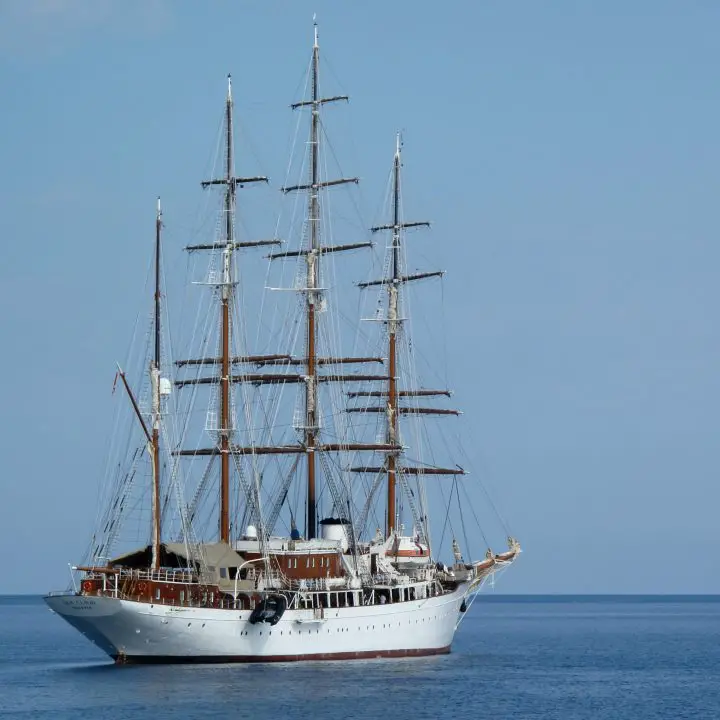
As a boater in South Florida, I became more aware of the differences between a boat and a yacht. You cannot navigate the waters between Fort Lauderdale, Palm Beach, and Miami for long without noticing a few other things that will qualify you as a yacht.
1. Yachts are nearly always operated by a professional crew who act as hosts for the owners and guests. There’s always a captain and chef, and usually stewards and deck hands too.
2. Yachts are flashy—they look expensive, and they are expensive. They shine, they’re always washed, and their wood and stainless glisten with perfection. After all, they have a full-time crew to tend to all of that.
3. While motor yachts are more common, there are plenty of beautiful sailing yachts on the water as well.
4. Yachts tend to be big. They need to be big enough for guests and crew to be comfortable. Plus, many are owned by business owners who use them to entertain.
5. Yachts spend much of their time with no guests/owners on board. Instead, the crew moves the yacht from one place to another, and the owner flies in to enjoy a few days a month onboard.
6. Many yachts are available for charter. While one person might own it and use it, they don’t spend all their time onboard. So when it’s still idle, it and its crew are leased out for days/weeks/months at a time.
Even within the subset of the motor yachts, there is significant variation and room for definition. To illustrate, some boats are designed to be sleek and modern, with the stately look of a yacht.
The term yachtie is commonly heard in port cities around the world as a person who gets off a yacht. Initially, this term was used only for wealthy owners or their guests. However, if you’re in a place where “yacht” means smaller boats, then any sailboat owner could be called a “yachtie.”
Nowadays, though, the term yachtie also could refer to the crew. Bravo TV’s Below Decks reality series focuses on the adventures and misadventures of the crews on these sorts of yachts.
More often than not, yachts are motorboats. But they aren’t just any motorboat. They are often sleek and fast ones that look like they just blasted out of the newest James Bond film.
There are also plenty of other styles of yacht on the ocean. Yachts take many shapes and forms since the best naval architects design them to suit whatever their clients want to do.
For example, some yacht owners use their boats to explore the Seven Seas. To do this, they might commission a custom expedition yacht or convert an old research vessel, fishing boat, or tugboat. These vessels are great for getting off the beaten track and taking any long trip.
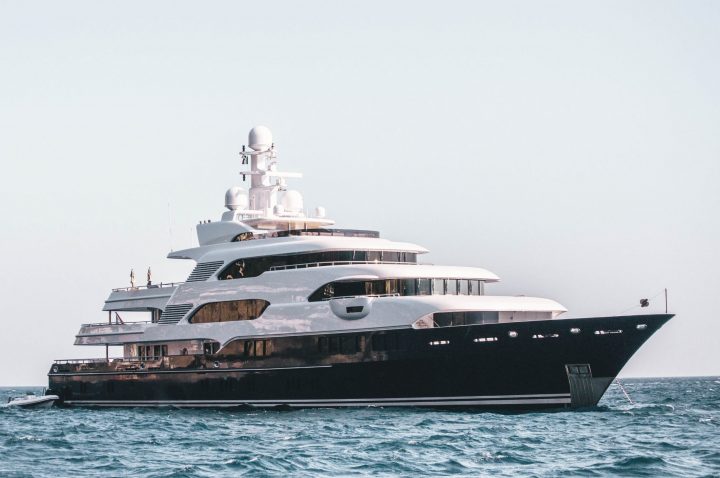
And similarly, some yacht owners want to sail. Some enjoy sailing for sailing’s sake, and others want their floating mansions to produce a smaller environmental impact by cutting down on their use of fossil fuels.
There are classic sailboat superyachts, like the three-masted schooner EOS . The EOS is the second-largest pure sailing yacht in the world at 305 feet (95 meters) long. She was launched in 2007 and is owned by movie billionaire Barry Diller and his wife, fashion designer Diane von Fürstenberg.
But you can’t compare the motor yacht vs sailing yacht without mentioning some of the other ultra-modern takes on the classic sailboat. The Maltese Falcon is a well-known sailing superyacht with three masts. But unlike the conventional schooner rig found on the EOS, the 288-foot (88-meter) Maltese Falcon has DynaRig technology . It looks like a square-rigger from the 1800s, but the masts can rotate, allowing it to sail upwind.
And for those who are still pondering sailing vs motor yacht design, you can’t miss Sailing Yacht A . Sailing Yacht A is sometimes noted as the largest sailing yacht in the world, but due to its unusual design, it is actually a “sail-assisted yacht.” In other words, this boat has sails, but it needs to run the motor to make way—the sails only help the motors.
How Big Is a Yacht?
With varying meanings worldwide, no single definition for the word yacht exists. Many brokers and charter companies loosely define a yacht as being at least 80 feet (24 meters) long.
In an industry where the lowest entry-level model needs to be big, luxurious, and fancy—how do different naval architects and boat makers differentiate themselves? In other words, how can a yacht be more than just a yacht?
The answer, of course, is to be a SUPER or a MEGA yacht. There’s no agreed-upon definition of what precisely these terms entail, but make no mistake–it takes a big yacht.
Worth Avenue Yachts, a global yacht broker and charter specialist company, postulates that a superyacht is at least 78 feet long (24 meters).
Furthermore, mega yachts are even grander. They start around the 200-foot (60-meter) line and keep getting bigger from there. The largest megayacht in the world is the 592-foot (180-meter) AZZAM . AZZAM was launched by Lürssen Yachts in 2013 was built for the President of the United Arab Emirates.
Yacht Aesthetics
So we’ve touched on the fact that yachts are usually pretty big, and in some cases really, really big. But there’s another thing that sets them apart from the typical sailboat, too. Yachts look different.
Generally, there are two aesthetics or looks that yachts take on, forming something of a motor yacht debate. Of course, this isn’t an inclusive list. Many designers work to make a statement with their yachts. The look of the finished vessel is a statement and an advertisement for the builder.
There are many yachts built that are designed right from the drawing board to turn heads. The most common way they do this is by making them modern and sleek, even futuristic at times.
Designers and builders put the latest technologies into yachts to appeal to early adopters of new technologies. What CEO or celebrity doesn’t want to own the world’s fastest yacht ?
And then there are futuristic-looking ones with forward-thinking designs. Boat International collected some of the craziest-looking yachts that are worth a look.
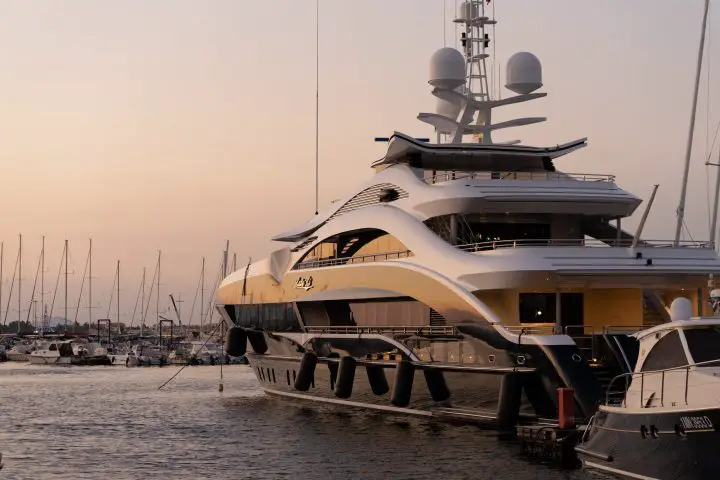
The yachts above get their title as yachts thanks to their value and size. But there’s another classification that you should consider—those yachts that get their name for their air of traditionalism.
Perhaps they are well-cared for or restored wooden hulled yachts from the 1920s or 30s. Many of these classics are sailing yachts , but that isn’t always the case.
In some cases, they are modern fiberglass or metal-hulled boats built recently and designed by contemporary designers. But their owners wanted that classic yacht aesthetic, so they created something that appears older than it is. Here’s a look at some of the nicest classic yachts out there.
What about Yacht Racing?
The older, more traditional British use of the word yacht seeps into everyday American English in a few places.
They’re more common on the international stage, so beyond the everyday use of yacht terms in the US, these particular uses harness a more global view of the word.
One such example is in the term yacht racing. Yacht racing sounds fancy, and it usually is, but it is entirely about sailboats. Yacht racing is usually done at a yacht club, another term that focuses on an older use of the word.
In the heydays of the yacht club, the line between the sort of crewed megayachts you see today and the person sailboat was blurrier. Fewer people had boats, and those boats that the wealthy could afford were divided between large crewed vessels and those small private boats kept at clubs. And, of course, one of the favorite activities at the yacht clubs was yacht racing.
Yacht clubs are still a thing, but they are less a part of everyday boating in the US than they used to be. Yacht clubs range from a local, passionate small boat sailing community to exclusive, elite social clubs with little to do with yachts.
Yacht racing is an international sport, although even the Olympics refer to it now as “sailing.” The oldest trophy in sports is the America’s Cup , and the competition for it is the pinnacle event in yacht racing.
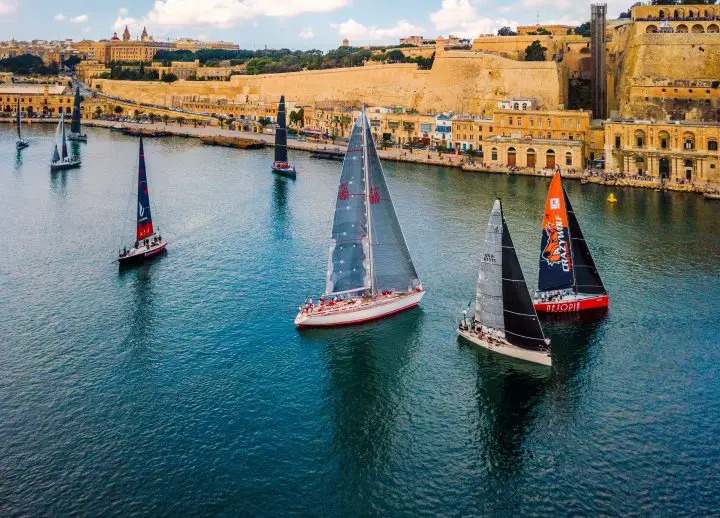
So how do you tell a yacht from other boats? It depends on several factors, but unlike a lot of things in boating, there really isn’t a right or wrong answer. If you want to call your new 20-foot pontoon a yacht or even a ship, go right ahead. However you want to enjoy life, the weather, sun, wind, or adventure, only one thing is for sure. Owning a boat makes it better!
To learn more about other boats and their comparisons, check out: Catamaran vs Pontoon
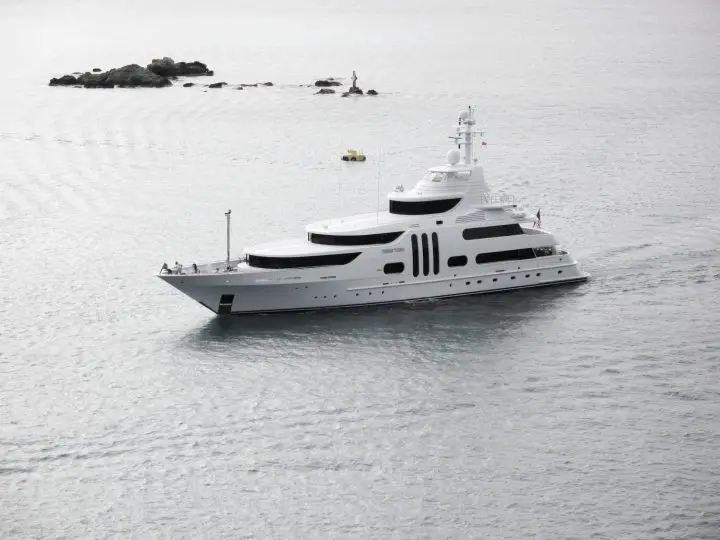
At what point does a sailboat become a yacht?
There is no definitive line where a sailing boat can be called a yacht. To some extent, you can use the word sailboat to describe any private, recreational sailing vessel. This is how the word is used in many parts of the world.
In the United States, the word yacht is usually reserved for crewed luxury vessels. To count as a yacht by this definition, the boat would need to be very high-end, sleek, and expensive. In short, it’s probably not a yacht if it’s under about 80 feet or so.
Are yachts or sailboats more expensive?
Yachts are more expensive, but it’s all in the definition of the word. In the US, the understood definition of a yacht is a luxurious sailboat or motor yacht. More often than not, yachts are big enough to require a professional crew.
On the other hand, a sailboat is any vessel that uses sails for power. So a yacht could be a sailboat, but not all sailboats are yachts. By the US definition, most sailboats are small and far from the lavish luxury you’d find on a yacht. But in some parts of the world, “yacht” is used interchangeably for a sailboat of any value.
Is a 40 foot sailboat a yacht?
The answer depends on where you are from. In parts of the world heavily influenced by British English tradition, the word yacht is often interchangeable with sailboat. If this sounds right, then a 40-foot sailboat could definitely be a yacht.
But in the US, the word yacht is usually reserved for large, lavish, and expensive vessels with professional crews—the types owned by celebrities and the super-wealthy. If this sounds more like your neighborhood, chances are a 40-foot sailboat is just a sailboat. On the other hand, if it doubles or triples in size and gets a crew, it might be bordering on yacht territory.
Is a sailing yacht cheaper than a yacht?
In general, the purchase price of yachts are roughly equal. While sailboats have more rigging and equipment, motor yachts have larger engines, so the prices are closer than you might imagine. There are too many variables to generalize when it comes to operating costs. In general, though, a fast-moving powerboat will always cost more than a slow-moving sailboat due simply to fuel costs.
If you’re thinking about chartering and want to compare the prices of sail versus power, companies like The Moorings Charters allow you to browse various destinations and boats. For example, a one-week charter on a 42-foot sail catamaran in the BVI starts at around $9,400. For comparison, that same charter on their smallest power catamaran, a 43 footer, starts at $11,070.
Matt has been boating around Florida for over 25 years in everything from small powerboats to large cruising catamarans. He currently lives aboard a 38-foot Cabo Rico sailboat with his wife Lucy and adventure dog Chelsea. Together, they cruise between winters in The Bahamas and summers in the Chesapeake Bay.

Sailboat Vs Yacht? 14 Things To Consider (Before You Choose)
Making a choice between a traditional sailboat and a yacht can often be difficult and maybe even a little confusing.
This is because the term boat and yacht are often used interchangeably.
In this article, we’ll assume a yacht is a boat that is over 26 feet in length with high-end materials used in its interior.
Here are 14 things to consider when deciding between a boat vs. a yacht:
Table of Contents
1) What’s The Desired Use Of The Vessel?
One of the first thoughts to keep in mind is your desired use:
- What do you want to do with your new boat?
- Do you want to go racing or deep-sea fishing?
- Or will you simply be cruising in the boat?
People looking for a boat to race probably won’t want to get a yacht.
This is because yachts focus more on luxury than they do on speed and maneuverability. As a result, the amenities are usually heavier.
An existing yacht can be laid out as a fishing vessel, but it wouldn’t make much sense to do so. This is because you’d have to change the deck area to make it more conducive to fishing.
In this case, it would be better to start off with a sport fishing boat/ yacht for this purpose instead. Big ocean-going sport fishing boats are just a specialized type of yacht.
A cruising trawler/ pilothouse vessel is another specialized type of yacht that is less expensive than a large express motor yacht, and they can be just as seaworthy.
2) Amenities To Consider

If you’re searching for a boat that features many amenities, you may want to consider getting a yacht over the other types of boats.
A yacht will often have features such as large refrigerators, washing machines, and dryers.
A really big yacht may also feature recreation amenities like hot tubs and even full-size pools to swim in. In fact, a mega-yacht might even have a pool large enough to swim laps in.
If you’re not into swimming inside of your boat, you can still take advantage of water features on your yacht. I’ve seen yachts with koi ponds and even waterfalls built into them.
Another amenity that many yacht owners enjoy is a built-in movie theater. These movie theaters have large projectors, plush seating, and can even feature porthole windows.
People can even get a good workout while out on their yachts in their own fitness centers. These fitness centers can be as simple as a few cardio machines and some dumbbells, or they can be state of the art centers that feature everything a commercial fitness center might have to offer.
A sailboat yacht can also have these types of amenities. An example of this is the Sailboat Yacht A, see here . But sailing yachts in general do not have as much room for amenities as the same size of power yacht.
On top of this, a sailboat yacht is often designed for rough ocean passages. The spaces of these yachts will be smaller, such a tighter galley kitchen. This doesn’t offer as much space for cooking but it does make it easier to cook without falling over during rough weather conditions.
3) Comfort Vs. Bunk Beds
Motor yachts tend to be much more comfortable than the average sailing yacht as well. This is because these motor yachts boats are usually made primarily with comfort in mind.
You’ll notice that saloon living spaces have leather couches and recliners throughout and that even the beds tend to be a bit more spacious.
Even the offices or navigation stations inside of a motor yacht tend to be outfitted with the most comfortable desks and chairs.
For people who are searching for more active comfort options, a motor yacht can have massage parlors, salons, and even saunas built into them. A traditional sailing yacht usually won’t have options like these, but it will be more comfortable to sail in and to sleep in while out in rough seas.
One example is that a sailboat will have handrails and foot rails in strategic places.
On top of this, a sailboat will have bunks that are easy to get in and out of and that also have bed rails so that sailors do not roll out of them when the weather gets rough.
4) Sailing Skills Needed
When you’re choosing between a sailing yacht and a motor yacht, you may want to consider what your level of sailing skills are.
A yacht can be purchased as a sailing yacht or a power yacht but a sailboat is always going to rely on its sails for any long-distance voyage.
Also, sailboats can be purchased in a wide variety of sizes.
A sailing yacht is usually longer than 26’. As a result, a yacht might be harder to sail than a traditional sailboat.
In fact, it may be impossible for you to sail a yacht by yourself. People with larger yachts will have to hire a crew to help them out each time they want to go sailing.
Here’s our guide to how big you can go before you need a crew for your boat .
5) Where Do I Get The Most For The Money?
A sailboat can have a lot of luxuries and comforts built into it. However, a sailboat doesn’t have to have these amenities built into it. As a result, you can save a lot of money by purchasing a basic sailboat.
Yachts, on the other hand, will always have expensive amenities to consider.
Because of this, you’ll pay a lot more for a motor yacht than you will a typical sailboat.
Also, sailboats can be smaller than yachts so you have more inexpensive boats to choose from when making your purchase. Yachts on the other hand usually start out well into the six-figure range and can go up into the millions depending on the size, age, and build quality of the yacht.
A yacht may also be harder to find in your area.
This is especially true if you’re buying a sailing yacht. The scarcity of yachts compared to the abundance of sailboats drives the prices of yachts up even more. This means that if you’re looking to buy a yacht in a part of the country that doesn’t have very many yachts available, you may pay an even bigger premium as well. Of course, large motor and sailing yachts are almost always kept on an ocean coast or maybe the Great Lakes, no matter where the owner lives.
6) Ongoing Expenses To Factor In
Yachts can often cost more to maintain than sailboats.
This is especially true if you’re buying a motor yacht. Boat engines require a lot of maintenance and the fuel costs can be prohibitive for many people.
For example, did you know that you might only be able to travel less than 1 nautical miles on a gallon of diesel fuel in a yacht? Go on a long journey out to sea and you could end up spending a fortune on fuel. A sailboat, on the other hand, will get you to where you want to go without hardly any fuel at all.
Even the insurance on a yacht is more expensive than it is on a sailboat. One reason is simply because of its designation as a yacht.
Here’s a complete guide we’ve made with insurance cost for boats . It will help you get an idea of what to expect.
Insurance companies will charge more just because of this designation.
Another reason the insurance is higher is that yachts are usually more expensive to buy than a sailboat. Because of this, yacht owners need to cover a larger dollar sum on their yacht than a sailboat owner does.
One advantage in ongoing expenses that a motor yacht owner does not have to contend with is the expense of maintaining, storing, and replacing the sails. A sailboat’s sails must constantly be monitored for damages and stored safely out of the sun and saltwater whenever possible.
With a motor yacht, you don’t have these issues.
7) Distances Traveled Between Ports

Even large motor yachts will still have limits to how far they can travel between ports.
This is because they simply run out of fuel at some point.
Sailboat owners don’t have this issue as much.
A sea-worthy sailboat can travel for as long as the crew can manage. In this case, the only limiting factor might be the amount of food that the sailboat owner can bring along.
For this reason, people looking to circumnavigate the world often opt to buy a large sailboat rather than a motor yacht. This also saves them on fuel costs so they won’t have any distance limits due to budget constraints.
Even yacht owners that plan to travel along island routes may still have limits as to how far they can travel. This is because replacement parts can’t always be found worldwide.
As a result, a yacht owner might end up stuck in one place while they wait for the arrival of a skilled yacht maintenance tech or a specialty part to arrive from overseas.
8) The Ability to Trailer The Boat
As we said earlier, the minimum size for a yacht is 26’ long. The width of a 26’ longboat is usually well over 8’ wide. Eight-foot is the maximum width that is allowed on many U.S. roads.
Even more lenient states will only allow for a maximum width of 8.5 feet.
As a result of all of this, it is impossible to trailer a yacht. This makes storage and travels more complicated and more expensive. It also makes it a lot less convenient.
A person looking for a boat that they can trailer will be better off buying a small sailboat. The mast could be taken down so that the boat can be taken through bridges and tunnels without damage to the boat.
In fact, a sailboat can technically be purchased in models that are small enough to be transported on top of a vehicle or within a truck bed.
These sailboats are highly mobile and can be fun to use recreationally.
9) Available Space On The Deck(s)
Sailboats don’t always have a lot of deck space. This is because much of their deck space is taken up with the mast, sails, and rigging. As a result, people looking for a boat with a large deck to hang out on would be better off buying a motor yacht.
A yacht is often designed with deck space in mind. In fact, a yacht will prioritize lounging areas on the deck. A large sailing catamaran will have much larger deck areas than a monohull sailboat.
Because of this, a yacht becomes a more social boat that is great for cruising and dock parties.
The downside of this, of course, is that you’ll have a larger deck to clean up each day. A yacht’s deck often needs to be cleaned every day just to keep the saltwater from damaging it.
10) Cruising Vs Sailing
A sailboat owner gets to experience the thrill of sailing.
They get to become one with the boat as it heels on the water and runs with the wind. This experience is a dream come true for many sailors.
For others, this experience is miserable. These people may be prone to seasickness, they might not like the excitement of sailing, or they simply might feel like it is too much work to be fun.
Motor yacht owners, on the other hand, get to cruise along the water at a comfortable pace and they don’t have to rely on the wind to take them anywhere. A yacht owner will travel in comfort but they’ll never get to experience the exhilaration that the sailboat owner gets to experience.
If you’re an adrenaline junky, you’ll probably gravitate more towards buying a sailboat. On the other hand, if you like to relax on the water with your friends, you may be more suited to motor yacht ownership.
11) Crew Quarters
The owners of large yachts will often hire crews to manage their boats for them.
Because of this, you’ll find luxury accommodations on one end of the boat with crew quarters on the other end of the boat.
In fact, you may even find that larger yachts have captain’s quarters as well.
A captain’s quarters are usually well-appointed and the captain will have his or her own head on-suite. Crew quarters are usually smaller and you’ll often have three crew members sleeping in the same room with bunks.
Sailboats can also have crew quarters but many of them are more democratized.
What I mean by this is that instead of several luxury quarters and a few crew quarters, you’re more likely to find a sailboat with quarters that are more even in size and capacity and you’re less likely to find berths with heads built into them.
12) Desired Length
It isn’t possible to buy a tiny yacht. The smallest yacht that you can buy that is still considered a yacht is 26’ long.
Sailboats, on the other hand, come in many different forms and many different sizes.
You can buy large sailing yachts that rival the size of motor yachts or you can buy small sailing vessels that you can put on top of your vehicle.
This versatility in size makes sailboat ownership more universal. Most people can buy a sailboat even with a modest income. Yachts, on the other hand, are much bigger and much more expensive.
As a result, you’ll find that only people with higher incomes or with a lot of interest in yachting will be willing to spend the money it takes to invest in a yacht .
13) Want To Join A Yacht Club?

Some yacht clubs are yacht clubs in name only. These clubs will allow anyone with a boat to join the club.
In some instances, people can join these clubs without ever even owning a boat.
More serious yacht clubs will insist that you own a yacht.
In fact, they may even have minimum boat requirements. For example, you may have to own a newer yacht or you may have to own a yacht of a certain size.
Here’s everything you need to know before you consider joining a yacht club . It’s a great guide we’ve made to help you understand how these clubs work.
If you’re looking to join a local yacht club, you may want to check with the club before you make your yacht purchase.
It would be unfortunate if you bought a brand new yacht only to find out that it was a foot or two shorter than it needed to be to meet the requirements of the yacht club.
Sailors have other club options.
A person looking to join a sailing yacht club may need to buy a certain type of sailboat. For example, a sailing club may only accept sailors with monohull sailboats.
In this case, you’d want to check with your local sailing clubs before making your purchase.
14) Renting or Buying?
Yachts and sailboats don’t need to be purchased outright. Some people will rent their boats for specific trips.
This can be especially advantageous for people who want to take a long trip on a yacht.
The reason for this is that the rented yacht might also come with a fully-staffed crew. This crew will have experience with the boat you’re renting so you won’t have to worry about having them trained.
People looking for a sailboat instead might also find renting to be better than buying.
Here’s a guide we’ve made with a long list of examples on renting prices on sailboats .
For example, a person could rent a different type of sailboat each time they decide to go out for a day of sailing. This gives them many different experiences and eliminates the storage, insurance, and maintenance costs.
In fact, even people who are looking to buy might want to start off by renting a few times first. This will give the potential boat owner the chance to explore their options before making a long-term commitment.
Here’s another article we’ve made with more things to think about if you are considering whether to rent or buy a boa t.
Before deciding which type of boat to buy, it is a good idea to determine what needs you prioritize the most. If you’re looking for an economical vessel to take on long-distance voyages, you may want to consider a sailboat or sailing yacht.
Otherwise, you could go with a motor yacht which might make cruising more pleasant.
Click to share...
Yacht or Sailboat: Deciding Your Luxury Sea Escape
Embark on a nautical adventure as we dive into the luxe life of yachts versus the windswept world of sailboats—your passport to choosing the ultimate vessel for your sea escapades awaits!

The world of boats is complicated to decipher because of how many types, models, and brands exist. Yachts and sailboats are two essential types of boats that are immediately recognizable by anyone. With that said, the yacht vs. sailboat debate ultimately comes down to several distinguishing factors between the two.
The main difference between yachts and sailboats is that sailboats have sails and yachts don’t. Sailboats are also smaller than yachts, feature fewer amenities, and cannot move quite as fast. Yachts are also much more expensive to purchase and maintain, and maintenance costs 20% of the initial cost each year which can cost tens of thousands of dollars.
It’s much easier to transport a sailboat than a yacht because yachts have to be shipped on a cargo deck. Conversely, you can attach the average sailboat to a trailer and tow it to a port. Follow along as we highlight the key differences between yachts and sailboats.
What Is The Difference Between a Yacht And a Sailboat?

The main differences between yachts and sailboats come down to size, amenities, and build . They serve the same purpose, but yachts and sailboats differ quite a bit when it comes to design. While not interchangeable, many prospective buyers struggle with whether or not to buy a yacht or a sailboat.
The yacht vs. sailboat debate has been discussed for decades, and it is ultimately subjective. However, many key differences can sway your opinion before you make a big purchase. Let’s take a look at the difference between yachts and sailboats and see why they matter.
Sails are the most immediately clear difference between yachts and sailboats. Sailboats always feature sails, but that’s not usually the case with yachts. The sail on a sailboat helps propel the vessel and is useful whether your boat has an engine or not .
Standard yachts lack sails because it would alter their appearance. Yachts are supposed to look sleek and luxurious which wouldn’t work as well with a sail. With that said, sailing yachts feature sails and are more often used for racing than cruising.
One of the downsides of traditional yachts is that you don’t get the aerodynamic boost that you would get with a sail . If you have a high-powered engine, this isn't a problem, but it will have to work harder without a sail under poor weather conditions.
The average sailboat is smaller than the average yacht. For example, the average yacht measures 78 feet long and the average sailboat measures 30 feet long . Yachts can be as small as 40 feet long or they can even exceed 100 feet long.
The world’s largest yacht measures 511 feet long and it is unsurprisingly owned by a multi-billionaire . Both yachts and sailboats vary in width depending on the floor plan and how many cabins they feature. Sailboats are generally slender because they feature a small galley and don’t typically include a cabin.
A superyacht is defined as a yacht that is 79 feet long or longer. However, you won’t find many superyachts out on the sea because they cost at least $3,000,000 in most cases.
Yachts are almost always much more expensive than sailboats. The difference in cost comes down to the many amenities that yachts are known for as well as the motor and size. Yachts start at $500,000 on the low end, but they can exceed $10,000,000 for superyachts over 79 feet long .
The more expensive a yacht is, the more expensive it will be to maintain because of the fuel demands and part replacements. There is more variety in cost when it comes to sailboats because they are a broad category of vessels. For example, a sailboat with no motor will cost thousands of dollars less than one that is motorized.
A motorized sailboat can cost as much as $250,000 or more whereas one without a motor may only cost $3,500 . Luxury sailboats with cabins can cost $500,000 but without the powerful performance of a yacht. With that said, sailboats cost less to maintain so even buying a high-end vessel may be a worthy investment.
Yachts have a higher capacity than sailboats because of how much bigger they generally are. There are often multiple decks on a yacht which makes it easy to host a large group of guests. Standard yachts can only accommodate 10-12 people, but large superyachts can hold more than double that in some cases .
Sailboats can typically hold 5-10 people, but it depends on the size of the vessel. You can calculate the capacity for a sailboat or yacht by multiplying the length and width and then diving that number by 15. Otherwise, you can simply refer to the capacity as recommended by the manufacturer.
It’s worth noting that boat manufacturers can only provide approximate estimates for capacity. They base the capacity on an average of 150 pounds per person, but that doesn’t apply to everybody.
Yachts are superior to sailboats when it comes to amenities in most cases. Sailboats sometimes feature a few amenities, such as a cabin or bathroom. However, yachts are considered luxury boats, so they are more likely to include special amenities such as built-in speakers and even TVs in some cases .
Some yachts even feature swimming pools and hot tubs, but they come at a premium price. They typically feature at least one deck to accommodate guests and some even feature helicopter pads . You won’t find nearly as many amenities on a sailboat because sailboats are more for practical use.
Larger sailboats may include a private deck and retractable sunshade. Otherwise, there isn’t usually enough space on a sailboat to include luxury amenities such as movie screens and infinity pools.
If you’re looking for a boat with comfortable quarters, then a yacht is ideal for you. Sailboats feature quarters in some cases as well, but yachts specifically emphasize comfort and luxury. Some yachts feature multiple cabins that can be used for lounging and sleeping alike .
You will also find larger cabins in yachts than sailboats which makes them much more comfortable. Yachts also often feature crew quarters because they sometimes require staff to operate the vessel. Sailboats are usually much smaller than yachts, and the cabins are suitably smaller as well.
You won’t likely find many sailboats with crew quarters unless it is a motorized vessel . Many manufacturers let you customize the floorplan and design for a yacht or sailboat. You can add a cabin to a boat that typically wouldn’t feature one, but it will delay how quickly you get it by up to a year or more in some cases.
Performance
Yachts are also faster than sailboats in most cases because of the powerful motor . Sailing yachts offer the best of both worlds because of the aerodynamic boost paired with the motor. Sailboats can still reach high speeds without a motor, especially if the wind is in your favor.
However, sailboats are faster than motorized yachts in some cases and can even reach speeds up to 12 knots or more. Yachts can operate at 10 knots at least, but massive yachts cannot usually maintain a high speed for long. High-performance yachts from bands such as Foners can reach speeds up to 70 knots, but that is rare .
Luxury yachts that measure 30-40 feet long can run at 30 knots in some cases as well. Otherwise, heavy yachts with an underpowered motor may only run at 10-20 knots.
It typically costs more to dock a yacht than a sailboat, but it depends on the size. Marinas charge varying rates to dock based on the location and the size of your boat. Boat length is one of the biggest cost factors, and they typically charge $10-$50 per foot of the vessel .
Yachts and sailboats can be similar in length, but yachts are often longer and wider making them more expensive to dock. Many yachts are considered liveaboard boats which can also add to the cost of docking at a marina. Marinas charge an extra fee if you plan to live on your yacht while docked, and not all of them even allow it .
You will also likely need to pay an extra fee to have your yacht or sailboat pumped at the marina. This is more common with yachts because they almost always feature at least one bathroom, but some sailboats do as well. Pumping may cost as little as $10-$20, but it’s better than having to empty your tank.
Maintenance
Maintenance is a reoccurring cost no matter what type of boat you have. With that said, you will likely need to spend much more to maintain a yacht than a sailboat. Motor sailboats may still require expensive maintenance, but it’s much less than for a yacht.
Yachts require routine maintenance to ensure that the motor and engine can continue to run smoothly. It costs 20% of the buying price per year to maintain the average yacht, and that adds up quickly . Yachts often cost over $1,000,000, so you could potentially spend up to $200,000 per year in fuel and maintenance in that case.
Traditional sailboats only cost an average of $3,500 per year to maintain, but they can cost as little as $1,500. Your maintenance costs may exceed $5,000 per year for a sailboat if it is motorized . Even still, it costs tens of thousands of dollars less per year to maintain the average sailboat than a yacht. It also costs much more to insure a yacht than a sailboat.
Sailboats can typically travel further without needing to stop than yachts. That is because yachts need to refuel which can limit how far you can travel from a port. However, motor sailboats have the same distance limitations as yachts because they rely on fuel.
Traditional sailboats don’t feature motors so they can essentially travel as far as possible until the crew needs to return. Sailing yachts may be able to travel further than standard yachts because of the aerodynamic boost . This can put less stress on the engine which can help save fuel to let you travel further.
Transportation
It’s much easier to transport a sailboat to a port or dock than a yacht. In many cases, you simply cannot trailer a yacht and you need to ship it as deck cargo. You can expect to spend at least $1,000 to ship a yacht as cargo, but it can cost much more for long distances .
Sailboats are easier to transport because you can attach them to a trailer and tow them to a port in most cases. You can tow a sailboat with a trailer as long as it is 22 feet long or smaller. Otherwise, you may need to have your sailboat shipped as cargo like you would need to for a yacht.
Yacht Pros and Cons

Yachts are understandably desirable to many, even if they may seem unattainable. Even still, yachts are complicated just like any type of boat and they have various pros and cons. Let’s take a look at the positive aspects of owning a yacht.
First and foremost, yachts are spacious and comfortable which makes them better than most boats. They almost always feature a large galley and at least one cabin that offers plenty of room. The luxurious appeal of yachts is that they come with many amenities making them akin to a mobile hotel on the water .
Yachts also feature powerful motors that are necessary to move their massive weight. You can fit at least 10 people on a yacht and over 20 on some huge models. This makes them the best boat to take out onto the water if you plan to entertain a large group of people.
- Comfortable cabins
- Plenty of deck space
- Convenient amenities
- Can reach high speeds
The high cost of docking at a marina is one of the biggest downsides of owning a yacht. They are so massive that spending a fortune on docking fees and club memberships is unavoidable. This is especially true if you plan to join a yacht club which can cost $7,000 or more per year depending on where you live.
Another key downside to a yacht is that they are a poor investment. The exorbitant cost of yearly maintenance paired with the depreciating value after using a yacht makes it nearly impossible to turn a profit . It can cost hundreds of thousands of dollars each year to maintain a yacht depending on how much you use it and how much the initial cost was.
- Maintenance costs a fortune
- Expensive to dock
- Requires a lot of fuel
- Needs to be shipped
Sailboat Pros and Cons

Much like yachts, sailboats aren’t without their problems. With that said, sailboats are also incredible vessels and continue to improve with each generation. Let’s take a look at the pros and cons of sailboats.
You can easily maintain a sailboat without spending nearly as much as you would on maintaining a yacht. That is because the engine on a sailboat is much simpler than one on a yacht which makes maintenance easier . You also get a boost from the wind as you move through the water with a sailboat because of how aerodynamic they are.
Another benefit of sailboats is that the engine doesn’t roar loudly likely a yacht does. This helps create a calm atmosphere for everyone on the boat which is essential when you are at sea. Most importantly, sailboats are inarguably much more affordable than yachts so they are easier for the average person to attain.
- Aerodynamic design
- Quiet operation
- Reasonably affordable
- Easy to maintain
One of the biggest downsides of sailboats is that they rely on great weather to operate at the optimal level. This is especially true if your sailboat isn’t motorized or simply has a weak engine that can’t keep up with bad weather. Sailboats are also usually much slower than yachts because their engines are less sophisticated.
They can also be difficult to steer in many cases, especially if you are new to sailing . You will also need to replace the sails several every 10 years or 4,000 hours of use, whichever comes first. Finally, sailboats aren’t known for having great amenities, such consider a yacht if you want luxury features.
- Can’t always reach high speeds
- Doesn’t feature many amenities
- Relies on great weather
- Difficult to steer
- Must replace sails
What Qualifies a Boat To Be a Yacht?

The criteria for a yacht are dubious and frequently, debated, but they typically measure at least 30-40 feet long . Yachts are also almost exclusively luxury boats that feature more amenities than a sailboat, fishing vessel, or pontoon. Most yachts feature cabins, a bathroom, a kitchen, a dinette, and a comfortable galley.
Yachts also typically lack sails, but there are sailing yachts on the market but they are a more recent addition to the world of boats. They also have a unique look that you can recognize right away even if you are unfamiliar with other vessels. Yachts often feature diesel engines that are powerful enough to move such a massive boat, and some of them come with multiple engines .
Can a Yacht Cross The Ocean?
Not all yachts can cross the ocean, but many of them can. It ultimately comes down to the fuel source and what kind of engine your yacht has . Yachts with multiple engines in particular can easily cross the ocean up to 3,000 miles in many cases.
It’s important to check the recommended nautical mileage of your yacht via the manufacturer before you attempt this. Many people live on their yachts, and in this case, supplies are an important factor to consider. It can take over a week to sail 3,000 miles depending on how many stops you make and how fast your yacht is .
In this case, you will need to make sure that your yacht has enough food and supplies to last you for at least a week. Ideally, you should plan a route that will let you stop at ports to refuel, pump your bathroom, and get more supplies to last for the rest of the trip. If this isn’t possible then it’s worth reconsidering and sailing a different route if you’re unsure about your yacht’s capabilities.
Is a Yacht Better Than a Sailboat?
Yachts are better than sailboats if you value amenities and speed . Sailboats don’t always include an engine, but when they do, it’s usually less impressive than a yacht’s engine. However, the sail on a sailboat gives it an aerodynamic boost that yachts simply don’t have.
Yachts are a poor investment compared to a sailboat because of how much they cost to maintain. You may have to spend up to 20% of the initial cost of a yacht per year to maintain the yacht. Overall, yachts and sailboats both have many pros and cons, but sailboats are a more affordable option if you are on a budget.
You may also like...
Jack archer pants review: better than lululemon.
In my quest to find the ultimate pair of travel pants that blend style, comfort, and functionality, I stumbled upon the Jack Archer Jetsetter Pants. Let me tell you...
Win a $500 Flight!
Embark on the adventure of a lifetime! Enter our Dream Journey Sweepstakes for a chance to win a $500 travel voucher, redeemable with any major US airline. Whether it's sandy beaches, bustling cities, or tranquil mountains, your dream destination is just an email away!*
Fisherman's Wharf in San Francisco: Top Eats, Sites, and Local Hacks
Imagine uncovering San Francisco's seaside heartbeat at Fisherman's Wharf—where adventures bob with the tides, flavors beckon, and parking secrets await your discovery. Dive into the ultimate Wharf wanderer's guide.
Beverly Hills Elite: 35 Star-Studded Mansions Revealed
Ever wondered where the stars align and sleep at night? Buckle up, as we take you on an exclusive zip code safari to unveil the plush pads of Beverly Hills' most glittering residents!
2024 Seville Safety Guide: Sun, Siestas & Secure Travels!
Ever dodged a wayward flamenco dancer or a rogue tapa? Fear not in Seville! Let's unravel the mysteries of safety in Spain's city of sun, siestas, and street charm. Stay tuned!
Jet-Setter on a Budget: Unlock Half-Price Student Airfares
Many airlines understand the financial constraints of students and offer special fares to make globetrotting more accessible. In this article, I'll dive into the airlines that provide these coveted student discounts.
Unlock Greek Bliss: Ideal Season Secrets & Fest Frenzy
Discover the best time to visit Greece's whitewashed villages, explore azure seas, immerse in rich history, and delight in Greek cuisine. Plan your dream trip now!
The travel site inspired by travelers and locals alike. Find amazing destinations, unique trip ideas, the best hotels, and most comfortable resorts.

Boating, Yachting, and Sailing: Is There a Difference?

Wondering what the difference between boating, yachting, and sailing is? In this article, we are going to break down each of these terms in-depth and share different examples of each.
So, is there a difference between boating, yachting, and sailing? Yes. Boating is a general term that refers to using a boat on the water. There are many kinds of boats, such as sailboats, which can be used for sailing and yachts, which can be used for fishing, living in, and boating.
So, while yachting and sailing are examples of boating, boating is not an example of yachting or sailing.
Read on to learn more about the similarities and differences between boating, yachting, and sailing.
What is a Boat?
A boat is a watercraft that comes in a large range of different types and sizes. A boat is defined to be a watercraft that is small enough to fit on a ship, which is usually no more than 1,000 feet long. A ship is a boat with a large size and carrying capacity that can carry other boats.
The size, shape, and capacity of a boat vary depending on what exactly the boat is being used for. Most often, boats are used for navigating areas near shore or inland waterways such as lakes and rivers, but they can be used on any water source.
Boats can be used for providing service to people and watercraft out on the water, recreational purposes, and commercial transportation of passengers and cargo across short distances.
Different Types of Boats
While hundreds of specific types of boats exist, the most popular types of boats are:
● Bowriders: best for families; seats 8+ people
● Cruisers: versatile, good for long trips
● Fishing Boats: built for fishing in either saltwater or freshwater
● Runabouts: controlled by a steering wheel; perfect for casual sports and recreational boating activities
● Sailboats: boats powered by sail
● Jet Boats: high maneuverability; very fast
● Pontoon Boats: popular for inland and other small bodies of water; great stability
● Watersport Boats: high speed and maneuverability for wakeboarding, tubing, and water skiing
● Yachts: most luxurious, great for parties or long trips
Each of these types of boats – along with many others – are designed to serve a specific purpose. Most often, these are recreational purposes such as leisure, fishing, or speed boating across open waters.
Boats are usually powered by either sail (sailboats), oars, or engines. From a simple wooden dinghy powered by rowing with oars to a luxurious high-output engine-powered yacht, there are boats for any kind of occasion.
What is Boating?
Boating is defined as the act of traveling on water in a boat for recreational purposes. Since there are so many different types of boats, there are different kinds of boating correlated with each type of boat. For example, you can go boating on a sailboat – which is sailboating – or go boating on a yacht – which is yachting. If you are out having fun on the water in a watercraft that isn’t a ship, you are boating.
What is a Yacht?

A yacht is defined to be a watercraft used for recreational purposes, most often pleasure and leisure. Yachts are considered to be one of the more luxurious, high-end types of boats available on the market. Some features of a yacht that distinguish it from other kinds of boats are its size (33 ft. and longer) and aesthetics. Yachts are usually going to have:
● A sharp prow
● Graceful lines
● Quality varnish that gleams from ~50 ft. away
● Shiny hull: no chalky gelcoat
● Neatly coiled lines
● Shiny hardware
● Properly flow burgees
● Jaunty ensign angles
● Varnished trim in the cabin
● Galley with comfortable bunks and an enclosed head
Another difference worth considering between yachts and other boats is that in addition to their premium aesthetics and features, yachts often have more navigational equipment meant for use for longer-range trips. This makes yachts and their insurance more expensive and comprehensive than other boats.
Different Types of Yachts

The different types of yachts are determined by their size, engine style, and specific uses. A yacht up to 100 ft. long is considered a yacht, while a yacht over 100 ft. long is considered a mega-yacht or superyacht. Yachts and mega-yachts are powered by either sail or engines.
Yachts powered by a motor in an engine are usually the most popular choice for large groups or families due to them having more space and stability. Sailing yachts come with all of the same levels of luxury as motor yachts and are best for those who enjoy traveling under sail. From there, it comes down to choosing between hull types (mono or multi) and choosing a style that will deliver the exact kind of performance you are looking for.
Some of the most popular types of yachts include:
● Sailing yachts: traditional sailing experience
● Explorer/Expedition yachts: built for long voyages
● Motor yachts: most popular choice for parties
● Classic yachts: older yachts; often handcrafted with wood
● Fishing yachts: best for fishing
● Gulet yachts: high stability and sturdiness; good for sailing
● Catamaran yachts: contains more than one hull; luxurious
● Cruisers: best for recreational trips; highly versatile
● Hybrid yachts: powered by hybrid propulsion systems: a combination of electric battery and engine power. Can switch between electric, diesel/electric, and full diesel mode.
● Open yachts/Sports cruisers: fast and sporty
What is Yachting?
Yachting is the act of either racing, cruising, navigating, or riding on the water in a yacht, which we defined above. This will most often be for recreational purposes such as leisure or pleasure. Basically, if you are out on the water in a yacht, you are yachting.
What is a Sailboat?
A sailboat is a specific kind of boat that incorporates a sail in its design. Sailboats can move across water due to the wind applying a force to the large sail that propels the entire boat forward. A sailboat is most often distinguished by its large mast with a triangular-shaped sail attached and minimalist design.
Sailboats differ from yachts in that yachts are often larger, have more features, and can be powered by an engine.
Different Types of Sailboats
Here are some of the most common types of sailboats and their uses:
● Beach catamarans: 14-20 ft. long, fast, agility is required
● Cruising catamarans: 25-50 ft. long, accommodation for extended cruising
● Cruising sailboats: 16-50+ ft. long, cabins for extended cruising; often seen in fleets for group cruising
● Daysailers: 14-20 ft. long, meant for day sailing, seat up to 4 passengers, great for beginners
● Motorsailers: 35 ft.+, powered with inboard engines for long cruises, trade speed for luxury due to the added weight of the engine, gas, and water tanks
● Racer-Cruisers: 25 ft.+, hybrid cruising boat built for both overnight cruising and competitive racing
● Racing sailboats: 20-70ft.+, fasted ride possible for racing
● Sailing dinghies: under 15 ft. long, room for one or two people, will be a wet ride.
What is Sailing?

Sailing is the act of navigating a sailboat that is being propelled forward by the wind, which applies a force to its sail. There are two types of sailing: cruising and racing.
Since sailing is most often done as a recreational activity, cruising is more common than racing. Cruising is simply gliding on the water with your sailboat, while racing (such as in the Olympics) is more competitive and is done by expert sailors.
Sailing isn’t the easiest task, but the basics can be learned within a few days if you are taught properly and in proper conditions such as calm water and gentle winds.
I am the owner of sailoradvice. I live in Birmingham, UK and love to sail with my wife and three boys throughout the year.
Recent Posts
How To Sail From The Great Lakes To The Ocean
It’s a feat in and of itself to sail to the Great Lakes. Now you want to take it one step further and reach the ocean, notably, the Atlantic Ocean. How do you chart a sailing course to get to the...
Can You Sail from the Great Lakes to the Gulf of Mexico by Boat? 
You have years of boating experience and consider yourself quite an accomplished sailor. Lately, you’ve been interested in challenging yourself and traveling greater distances than ever before. If...
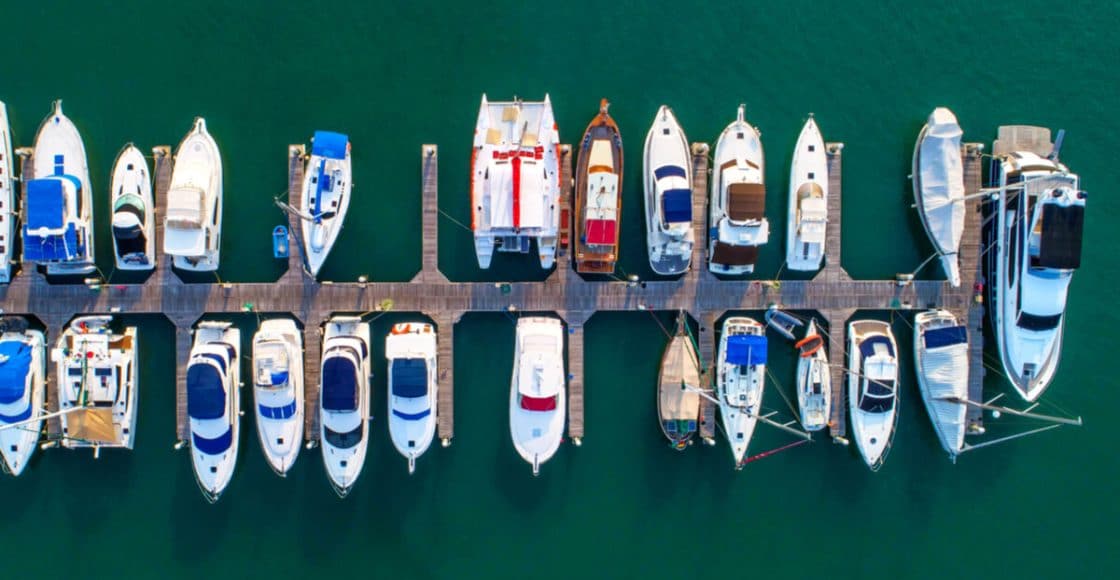
Yachts vs. Boats: What are the Differences?

Table of Contents
Many people use the words “boat” and “yacht” interchangeably, and some lean on the latter to make their ride sound more impressive. But what are the key differences between boats and yachts?
First, let’s look at some broad definitions of a boat, a yacht, and other related vessels.
- “Boat” can refer to just about any kind of vessel— towboat , fishing boat , center console , houseboat , and so on.
- “Dinghy” designates a small boat with a human or wind means of propulsion including a rowing dinghy or sailing dinghy. It also refers to a tender to a bigger boat or yacht.
- “Ship” is a large commercial boat, often used for distance travel and transport of goods or passengers – cruise ship, container ship, etc.
- “Yacht” is typically a larger boat with luxury amenities used as a recreational vessel— motor yacht , sailing yacht .
- “Superyacht” is a large yacht and is often also called a mega yacht . The delineation used to be at 80-feet but again, with today’s size creep, anything under 100 feet would just simply be called a yacht.
So, yacht or boat? Let’s dive deeper into the elements that differentiate a boat from a yacht.
Own a Boat or a Yacht? Learn How to Offset the Cost of Ownership by Listing on Boatsetter
Size of the Vessel
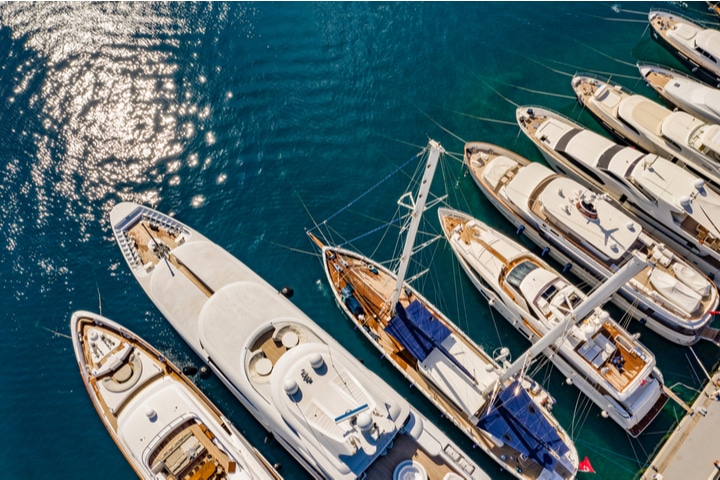
Some place a hard line at 35 feet. Below that, you have a boat and above, it’s a yacht. However, that’s an artificial differentiator.
Just 30 years ago, a 30-foot boat was considered large and could have been a yacht but as recreational boats grow longer, the term yacht has been pushed up the scale.
That said, a well-kept 40-foot boat designed for recreation can technically still be called a yacht (although larger vessels are likely to cost more, price isn’t a good indicator of yacht status primarily because it fluctuates with brand, age, and amenities).
Check out local yacht rentals near you to understand how size plays a difference.
What it’s Used For
A yacht is a vessel designed for recreational purposes. It generally operates on open waters (rather than small lakes or rivers) and has accommodations for overnight guests.
A cruise ship, on the other hand, accommodates a large number of passengers in a commercial setting whereas a yacht carries a smaller number (of paying or non-paying) passengers for private recreation.
Onboard Technology
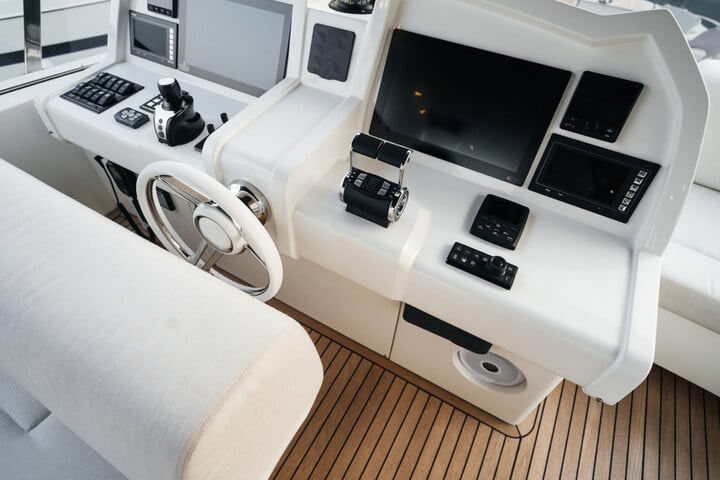
Advanced technology for navigation, communications, and system operation as well as redundant systems for safety can be found on a yacht that is likely to venture farther.
Again, there are caveats because today’s towboats that are fun day boats also feature technology such as GPS and digital switching that integrates many electrical and electronic features.
Propulsion Types
This is a tricky one. “Yacht” comes from the Dutch word “jaght” which referred to a sailing vessel that was used by the navy to capture pirate ships and later for recreation by the affluent.
Today, a yacht can be a large sailing vessel or a motor yacht. All larger yachts will have a motor for propulsion whether they have sails or not. Sailboats by design have smaller motors so trying to put a horsepower minimum on yacht propulsion is simply inaccurate.
Some define a yacht as having multiple crews to operate the vessel and tend to passengers or guests. The larger the yacht, the more crew will be required to navigate, maintain and service the vessel. That said, a couple who owns a 50-footer can call their boat a yacht although it’s owner-operated.
Luxury and Amenities
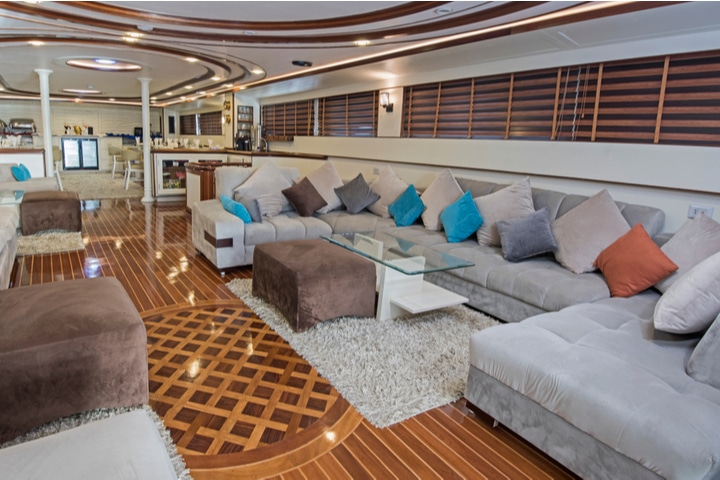
This is perhaps the best measure of a yacht. If the vessel offers accommodations, a galley , a head , and is luxurious in its presentation, it’s most likely a yacht.
That said, there are lots of center console fishing boats and towboats that are pretty nicely equipped these days and they wouldn’t be called a yacht.
All yachts are boats, but not all boats are yachts—and the lines are blurry. The word yacht elicits images of posh seafaring experiences while a boat evokes ideas of fun and perhaps work. Do some research to learn what size and type of boat or yacht is best for you .
To a degree, the point at which a boat becomes a yacht is in the ear of the beholder but if you focus on size, amenities, and the type of use, you’ll be able to discern the difference. Then all that remains is to find a way to spend time and have fun on any kind of vessel.
Browse All Available Boat & Yacht Rentals Across the Globe

Zuzana Prochazka is an award-winning freelance journalist and photographer with regular contributions to more than a dozen sailing and powerboating magazines and online publications including Southern Boating, SEA, Latitudes & Attitudes and SAIL. She is SAIL magazines Charter Editor and the Executive Director of Boating Writers International. Zuzana serves as judge for SAIL’s Best Boats awards and for Europe’s Best of Boats in Berlin.
A USCG 100 Ton Master, Zuzana founded and manages a flotilla charter organization called Zescapes that takes guests adventure sailing at destinations worldwide.
Zuzana has lived in Europe, Africa and the United States and has traveled extensively in South America, the islands of the South Pacific and Mexico.
Browse by experience

Explore articles
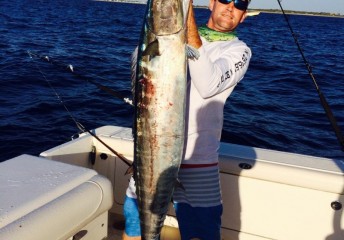
Real Boatsetter Charter Boat Captains - Real Success Stories
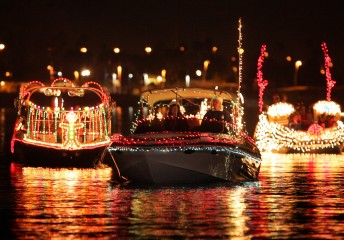
Top 10 Lighted Boat Parades to Check Out This Holiday Season
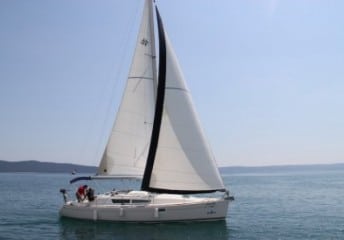
Best Small Boats to Rent or Buy in 2016
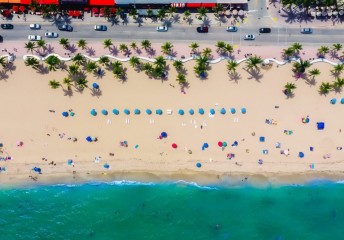
Your Fort Lauderdale Air and Sea Show boat rental will get you front + center!

Types of Sailboats: A Complete Guide

Last Updated by
Daniel Wade
June 15, 2022
Learning the different types of sailboats can help you identify vessels and choose the right boat.
In this article, we'll cover the most common kinds of sailboats, their origins, and what they're used for. We'll also go over the strengths and weaknesses of each design, along with when they're most useful.
The most common kind of sailboat is the sloop, as it's simple to operate and versatile. Other common sailboat types include the schooner, cutter, cat, ketch, schooner, catamaran, and trimaran. Other sailboat variations include pocket cruisers, motorsailers, displacement, and shoal-draft vessels.
The information found in this article is sourced from boat reference guides, including A Field Guide to Sailboats of North America by Richard M. Sherwood and trusted sources in the sailing community.
Table of contents
Distinguishing Types of Sailboats
In this article, we'll distinguish sailboats by traits such as their hull type, rig, and general configuration. Some sailboats share multiple characteristics with other boats but fall into a completely different category. For example, a sailboat with a Bermuda rig, a large engine, and a pilothouse could technically be called a sloop, but it's more likely a motorsailer.
When discerning sailboat type, the first most obvious place to look is the hull. If it has only one hull, you can immediately eliminate the trimaran and the catamaran. If it has two or more hulls, it's certainly not a typical monohull vessel.
The next trait to consider is the rig. You can tell a lot about a sailboat based on its rig, including what it's designed to be used for. For example, a long and slender sailboat with a tall triangular rig is likely designed for speed or racing, whereas a wide vessel with a complex gaff rig is probably built for offshore cruising.
Other factors that determine boat type include hull shape, overall length, cabin size, sail plan, and displacement. Hull material also plays a role, but every major type of sailboat has been built in both wood and fiberglass at some point.
Sailboat vs. Motorsailer
Most sailboats have motors, but most motorized sailboats are not motorsailers. A motorsailer is a specific kind of sailboat designed to run efficiently under sail and power, and sometimes both.
Most sailboats have an auxiliary engine, though these power plants are designed primarily for maneuvering. These vessels cannot achieve reasonable speed or fuel-efficiency. Motorsailers can operate like a powerboat.
Motorsailers provide great flexibility on short runs. They're great family boats, and they're popular in coastal communities with heavy boat traffic. However, these features come at a cost. Motorsailers aren't the fastest or most efficient powerboats, and they're also not the most agile sailboats. That said, they make an excellent general-purpose sailing craft.
Monohull vs. Multi-hull: Which is Better?
Multihull sailboats are increasingly popular, thanks to advances and lightweight materials, and sailboat design. But are they better than traditional sailboats? Monohulls are easier to maintain and less expensive, and they offer better interior layouts. Multihulls are more stable and comfortable, and they're significantly easier to control. Multihull sailboats also have a speed advantage.
Monohull Sailboats
A monohull sailboat is a traditionally-shaped vessel with a single hull. The vast majority of consumer sailboats are monohulls, as they're inexpensive to produce and easy to handle. Monohull sailboats are proven and easy to maintain, though they lack the initial stability and motion comfort of multi-hull vessels.
Monohull sailboats have a much greater rig variety than multi-hull sailboats. The vast majority of multihull sailboats have a single mast, whereas multi-masted vessels such as yawls and schooners are always monohulls. Some multi-hull sailboats have side-by-side masts, but these are the exception.
Catamaran Sailboats
The second most common sailboat configuration is the catamaran. A catamaran is a multihull sailboat that has two symmetrical hulls placed side-by-side and connected with a deck. This basic design has been used for hundreds of years, and it experienced a big resurgence in the fiberglass boat era.
Catamarans are fast, efficient, and comfortable. They don't heel very much, as this design has excellent initial stability. The primary drawback of the catamaran is below decks. The cabin of a catamaran is split between both hulls, which often leaves less space for the galley, head, and living areas.
Trimaran Sailboats
Trimarans are multi-hull sailboats similar to catamarans. Trimarans have three hulls arranged side-by-side. The profile of a trimaran is often indistinguishable from a catamaran.
Trimarans are increasingly popular, as they're faster than catamarans and monohulls and considerably easier to control. Trimarans suffer from the same spatial limitations as catamarans. The addition of an extra hull adds additional space, which is one reason why these multi-hull vessels are some of the best-selling sailboats on the market today.
Sailboat Rig Types
Rigging is another way to distinguish sailboat types. The rig of a sailboat refers to it's mast and sail configuration. Here are the most common types of sailboat rigs and what they're used for.
Sloops are the most common type of sailboat on the water today. A sloop is a simple single-mast rig that usually incorporates a tall triangular mainsail and headsail. The sloop rig is easy to control, fun to sail, and versatile. Sloops are common on racing sailboats as they can sail quite close to the wind. These maneuverable sailboats also have excellent windward performance.
The sloop rig is popular because it works well in almost any situation. That said, other more complex rigs offer finer control and superior performance for some hull types. Additionally, sloops spread their entire sail area over just to canvases, which is less flexible than multi-masted rigs. The sloop is ideal for general-purpose sailing, and it's proven itself inland and offshore.
Sloop Features:
- Most popular sailboat rig
- Single mast
- One mainsail and headsail
- Typically Bermuda-rigged
- Easy to handle
- Great windward performance
- Less precise control
- Easier to capsize
- Requires a tall mast
Suitable Uses:
- Offshore cruising
- Coastal cruising
Cat (Catboat)
The cat (or catboat) is a single-masted sailboat with a large, single mainsail. Catboats have a thick forward mast, no headsail, and an exceptionally long boom. These vessels are typically gaff-rigged, as this four-edged rig offers greater sail area with a shorter mast. Catboats were popular workboats in New England around the turn of the century, and they have a large following today.
Catboats are typically short and wide, which provides excellent stability in rough coastal conditions. They're hardy and seaworthy vessels, but they're slow and not ideal for offshore use. Catboats are simple and easy to control, as they only have a single gaff sail. Catboats are easy to spot thanks to their forward-mounted mast and enormous mainsail.
Catboat Features:
- Far forward-mounted single mast
- Large four-sided gaff sail
- Short and wide with a large cockpit
- Usually between 20 and 30 feet in length
- Excellent workboats
- Tough and useful design
- Great for fishing
- Large cockpit and cabin
- Not ideal for offshore sailing
- Single sail offers less precise control
- Slow compared to other rigs
- Inland cruising
At first glance, a cutter is difficult to distinguish from a sloop. Both vessels have a single mast located in roughly the same position, but the sail plan is dramatically different. The cutter uses two headsails and often incorporates a large spar that extends from the bow (called a bowsprit).
The additional headsail is called a staysail. A sloop only carries one headsail, which is typically a jib. Cutter headsails have a lower center of gravity which provides superior performance in rough weather. It's more difficult to capsize a cutter, and they offer more precise control than a sloop. Cutters have more complex rigging, which is a disadvantage for some people.
Cutter Features:
- Two headsails
- Long bowsprit
- Similar to sloop
- Gaff or Bermuda-rigged
- Fast and efficient
- Offers precise control
- Superior rough-weather performance
- More complex than the sloop rig
- Harder to handle than simpler rigs
Perhaps the most majestic type of sailboat rig, the schooner is a multi-masted vessel with plenty of history and rugged seaworthiness. The schooner is typically gaff-rigged with short masts and multiple sails. Schooners are fast and powerful vessels with a complex rig. These sailboats have excellent offshore handling characteristics.
Schooners have a minimum of two masts, but some have three or more. The aftermost large sail is the mainsail, and the nearly identical forward sail is called the foresail. Schooners can have one or more headsail, which includes a cutter-style staysail. Some schooners have an additional smaller sale aft of the mainsail called the mizzen.
Schooner Features:
- At least two masts
- Usually gaff-rigged
- One or more headsails
- Excellent offshore handling
- Precise control
- Numerous sail options (headsails, topsails, mizzen)
- Fast and powerful
- Complex and labor-intensive rig
- Difficult to adjust rig single-handed
- Offshore fishing
Picture a ketch as a sloop or a cutter with an extra mast behind the mainsail. These vessels are seaworthy, powerful, excellent for offshore cruising. A ketch is similar to a yawl, except its larger mizzen doesn't hang off the stern. The ketch is either gaff or Bermuda-rigged.
Ketch-rigged sailboats have smaller sails, and thus, shorter masts. This makes them more durable and controllable in rough weather. The mizzen can help the boat steer itself, which is advantageous on offshore voyages. A ketch is likely slower than a sloop or a cutter, which means you aren't likely to find one winning a race.
Ketch Features:
- Headsail (or headsails), mainsail, and mizzen
- Mizzen doesn't extend past the rudder post
- Good offshore handling
- Controllable and mild
- Shorter and stronger masts
- Easy self-steering
- Slower than sloops and cutters
- Less common on the used market
A dinghy is a general term for a small sailboat of fewer than 28 feet overall. Dinghys are often dual-power boats, which means they usually have oars or a small outboard in addition to a sail. These small boats are open-top and only suitable for cruising in protected waters. Many larger sailboats have a deployable dinghy on board to get to shore when at anchor.
Dinghy Features:
- One or two people maximum capacity
- Easy to sail
- Works with oars, sails, or an outboard
- Great auxiliary boat
- Small and exposed
- Not suitable for offshore use
- Going from anchor to shore
- Protected recreational sailing (lakes, rivers, and harbors)
Best Sailboat Type for Stability
Stability is a factor that varies widely between sailboat types. There are different types of stability, and some sailors prefer one over another. For initial stability, the trimaran wins with little contest. This is because these vessels have a very high beam-to-length ratio, which makes them much less prone to rolling. Next up is the catamaran, which enjoys the same benefit from a wide beam but lacks the additional support of a center hull section.
It's clear that in most conditions, multihull vessels have the greatest stability. But what about in rough weather? And what about capsizing? Multihull sailboats are impossible to right after a knockdown. This is where full-keel monohull sailboats excel.
Traditional vessels with deep displacement keels are the safest and most stable in rough weather. The shape, depth, and weight of their keels keep them from knocking over and rolling excessively. In many cases, these sailboats will suffer a dismasting long before a knockdown. The primary disadvantage of deep-keeled sailboats is their tendency to heel excessively. This characteristic isn't hazardous, though it can make novice sailors nervous and reduce cabin comfort while underway.
Best Sailboat Type for Offshore Cruising
The best sailboat type for offshore cruising is the schooner. These graceful aid robust vessels have proven themselves over centuries as durable and capable vessels. They typically use deep displacement keels, which makes them stable in rough weather and easy to keep on course.
That said, the full answer isn't quite so simple. Modern multihull designs are an attractive option, and they have also proven to be strong and safe designs. Multihull sailboats are an increasingly popular option for offshore sailors, and they offer comfort that was previously unknown in the sailing community.
Many sailors cross oceans in basic Bermuda-rigged monohulls and take full advantage of a fin-keel design speed. At the end of the day, the best offshore cruising sailboat is whatever you are comfortable handling and living aboard. There are physical limits to all sailboat designs, though almost any vessel can make it across an ocean if piloted by a competent skipper and crew.
Best Sailboat Type for Racing The modern lightweight Bermuda-rigged sailboat is the king of the regatta. When designed with the right kind of hull, these vessels are some of the fastest sailboats ever developed. Many boats constructed between the 1970s and today incorporate these design features due to their favorable coastal and inland handling characteristics. Even small sailboats, such as the Cal 20 and the Catalina 22, benefit from this design. These boats are renowned for their speed and handling characteristics.
Related Articles
I've personally had thousands of questions about sailing and sailboats over the years. As I learn and experience sailing, and the community, I share the answers that work and make sense to me, here on Life of Sailing.
by this author
Learn About Sailboats
Most Recent

What Does "Sailing By The Lee" Mean?
October 3, 2023

The Best Sailing Schools And Programs: Reviews & Ratings
September 26, 2023
Important Legal Info
Lifeofsailing.com is a participant in the Amazon Services LLC Associates Program, an affiliate advertising program designed to provide a means for sites to earn advertising fees by advertising and linking to Amazon. This site also participates in other affiliate programs and is compensated for referring traffic and business to these companies.
Similar Posts

Affordable Sailboats You Can Build at Home
September 13, 2023

Best Small Sailboat Ornaments
September 12, 2023

Discover the Magic of Hydrofoil Sailboats
December 11, 2023
Popular Posts

Best Liveaboard Catamaran Sailboats
December 28, 2023

Can a Novice Sail Around the World?
Elizabeth O'Malley

4 Best Electric Outboard Motors

How Long Did It Take The Vikings To Sail To England?


10 Best Sailboat Brands (And Why)
December 20, 2023

7 Best Places To Liveaboard A Sailboat
Get the best sailing content.
Top Rated Posts
Lifeofsailing.com is a participant in the Amazon Services LLC Associates Program, an affiliate advertising program designed to provide a means for sites to earn advertising fees by advertising and linking to Amazon. This site also participates in other affiliate programs and is compensated for referring traffic and business to these companies. (866) 342-SAIL
© 2024 Life of Sailing Email: [email protected] Address: 11816 Inwood Rd #3024 Dallas, TX 75244 Disclaimer Privacy Policy
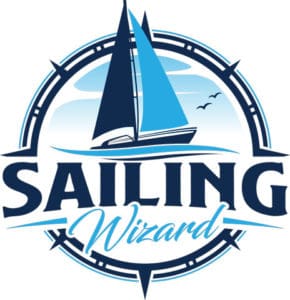
What’s the Difference Between a Boat, Yacht & Ship?
Whether you are a brand new sailor or just wanting to brush up on some terms, it is essential to know what to call a particular watercraft if you’re going to fit in while you’re at the docks or out on the water. There are many nuances and subtle differences between water vessel types, but below are some of the main differences.
In general, yachts are either sailing or motor vessels used for pleasure. Yachts are often luxurious and equipped with an overnight cabin. Boats can be either propelled sail or a motor and come in varying sizes. On the other hand, ships are usually motor-powered and much larger than boats.
Some of the differences between watercraft types can be a little fuzzy, but once you grasp the main differences between them, it becomes relatively easy to tell them apart. If you have no previous knowledge of watercraft, you are likely very confused about what defines a yacht, boat, and ship, so I’ll try to clarify any confusion you might have in the next few sections.
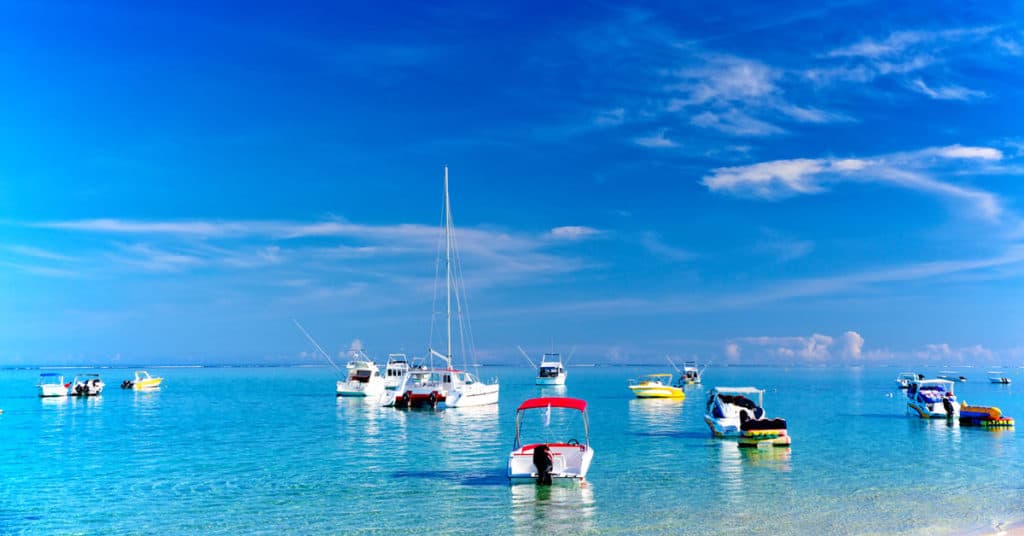
Similarities and Differences Between Boats, Yachts, and Ships
The many bodies of water all over the world are home to an extensive collection of different watercraft. There are so many shapes and sizes that they come in that it is nearly impossible to fit every single one into a specific classification.
However, in the following table, I did my best to loosely define ships, yachts, and boats so that it is easy to see the differences between the types of watercraft.
As I mentioned earlier, it is impossible to fit EVERY SINGLE water vessel into a particular category, so there are tons of exceptions out there. In addition to the exceptions, different organizations, laws, and people classify types of boats slightly differently.
There is no universally accepted definition for ships, boats, and yachts, but instead many different sets of rules and regulations. In this article, I have tried my best to use the most commonly accepted definitions for each watercraft type.
Now that we’ve gone over some of the main differences and similarities between boats, ships, and yachts, let’s take a look at each type of vessel individually and look at their most prominent characteristics and attributes.
What Exactly is a Boat?
Boats come in a vast array of sizes and shapes. To many people, the term “boat” simply refers to nearly any watercraft, but there are actually a few restrictions and defining characteristics that all boats have. So let’s just get right into it and take a quick look at what exactly qualifies a vessel as a boat.
Overall Size of Boats
As I said before, there is a massive catalog of different types of boats, and they come in a variety of sizes. There are huge boats that hold lots of cargo or people, and then there are smaller ones that barely can stay afloat with a single person on board.
Typically, boats are defined as watercraft that are less than 197 feet long. However, most boats you are likely to encounter on the water are usually around 30 feet long.
General Price Range of Boats
Again, it is hard to accurately give a price range for all boats because they come in so many different sizes, styles, and types, but most modern boats seem to fall in the $1,500 to $100,000 range.
Small Jon boats can cost even less than $1,500, while large sailboats and houseboats can cost well above $100,000.
Most Common Uses of Boats
Boats are used all over the world for a variety of different reasons and to do many tasks. Many types of boats serve a wide range of uses, but most are primarily used as a residence, for pleasure, or commercially.
Some of the most popular types of boats, such as sailboats, bowriders, and dinghies, are commonly used for enjoyment, fishing, racing, or other pleasurable activities. There are also many types of houseboats used as residences and commercial boats used for chartering or moving goods or people.
Propulsion Method of Boats
Due to the wide variety of boats, you are likely to find boats propelled by almost every propulsion method imaginable. Some of the more popular propulsion methods for boats to use are man-power, wind power, and motor power.
Boats on the smaller end often use the power of the people on board to row or paddle, while larger boats rely on sails or powerful motors attached to the stern. Many boats use more than one propulsion method, either together or with one of them as a backup.
What Exactly is a Yacht?
Yachts have many of the same attributes as boats, but their quality, size, and luxury really set them apart. When someone says “yacht,” many people imagine watercraft that are SUPER LARGE, and while there are lots of massive yachts, many smaller boats also qualify as yachts, which might surprise you.
Overall Size of Yachts
There are many different sized yachts, and the rules regarding how big they have to be are not very strict. In general, luxury watercraft greater than 33 feet in length are considered yachts. However, boats smaller than 33 feet are sometimes called yachts if they are exceptionally luxurious and elegant.
There is no upper limit to how large a yacht can be. Yachts longer than 100 feet are often referred to as mega yachts, and ones over 150 feet long called are super yachts.
General Price Range of Yachts
Because the very definition of a yacht requires it to be very luxurious, they often come with quite a price tag as a result. There is quite a range of different price points for yachts, ranging from $250,000 to $50,000,000 and beyond.
Most Common Uses of Yachts
Yachts, because they are so expensive to maintain and purchase, are primarily used for pleasure purposes. Day trips out on the water are typical for yachts, although they often have overnight cabins, so longer excursions are popular.
Chartered yachts are also very popular, which bridges the gap between commercial and pleasure. Although, when you are on a chartered yacht, it is usually for the sole purpose of having a great time and enjoying yourself.
Propulsion Method of Yachts
Because yachts are considered very luxurious and often so large, they are usually solely propelling using motor power. Even if a yacht is on the smaller end of the spectrum, they often only use a motor as a means of driving the craft through the water.
However, many large sailing yachts out there use sails and the wind to propel the vessel. So while the large majority of yachts use motors, keep in mind that some large and luxurious sailboats can be considered yachts.
What Exactly is a Ship?
Throughout history, large ships have been a helpful tool for many civilizations and have allowed them to transport goods and explore places beyond their homes. In modern times, ships are quite common and are used for a variety of different reasons.
Overall Size of Ships
One of the primary characteristics of ships that set them apart from boats is their size. Ships, especially in modern times, are often MASSIVE and are restricted to navigating only extensive waterways.
Vessels greater than or equal to 197 feet long are often considered ships. However, most ships today are huge and often fall in the 1,000-foot range or larger.
General Price Range of Ships
Most individuals will never own a ship due to their extreme maintenance and the cost of purchasing one. While many smaller ships are far less expensive, most modern ships cost anywhere between $50 and $500 million.
Large and luxurious cruise ships can even cost upwards of $1 billion to construct, and that’s not even taking into account staff, maintenance, and other costs.
Most Common Uses of Ships
Ships perform many different duties throughout the world, but usually, they are used to transport passengers or goods over long distances. In addition, they are also often used by military, scientists, fishers, and a plethora of other professions and people. They are also often used for pleasure purposes, in the form of passenger cruise ships.
Overall, ships encompass a large selection of vessels that perform many different duties.
Propulsion Method of Ships
Due to their large size, most modern ships are propelled using motors. However, even though ships are equipped with massive motors, they are still pretty slow and often move at around 20 knots per hour, although some move much quicker.
While most, if not all, ships today use motors to propel themselves through the water, this was not always the case. Before motors were around, many civilizations used ships for military, exploration, transportation, shipping, and many other uses. During these times, ships were powered primarily by man and wind power. Even today, you can occasionally find a sail-powered ship, though they are quite rare.
James Gerard
Hi, I'm James! I started sailing at a very early age here in the UK, and have enjoyed so many opportunities to sail all over the world. I created this website to share the many sailing tips I've leaned over the years, so that you can also discover the joy of sailing with safety and confidence.
Recent Posts
How to Predict Wind Direction & Speed from a Surface Pressure Chart
Learning how to read a surface pressure chart will allow you to predict the wind speed and direction based on the weather chart. This will help you in planning your next sailing trip.
What Does a Black & Yellow Buoy Mean? (Cardinal Marks Explained)
If you see a black and yellow buoy while you're sailing, don't ignore it. Cardinal Marks are there to help you avoid hidden hazards in the water. This helpful article will help you to identify a...

+385 21 55 33 01 +385 91 3000 009
+385 91 3000 009

Sailing vs. Motor Yachts: Which One is Right for Your Vacation?
Introduction: exploring the choice between sailing and motor yachts for your vacation.
When planning a vacation on the water, one of the first decisions you’ll need to make is whether to choose a sailing or motor yacht. Both options offer unique experiences, and understanding the differences can help you make the right choice for your vacation. Sailing yachts provide a sense of adventure and a connection to the elements, as you harness the wind to propel you forward. On the other hand, motor yachts offer speed, convenience, and the ability to reach your destination quickly. By exploring the pros and cons of each option, you can ensure that your vacation is tailored to your preferences and desires.
Sailing yachts: Advantages and characteristics
Sailing yachts offer a unique and authentic experience for those seeking a memorable vacation on the water. Unlike motor yachts, sailing yachts harness the power of the wind, allowing you to truly connect with the elements and enjoy a serene and peaceful journey. The gentle sway of the boat and the sound of the sails fluttering in the wind create a sense of tranquility and relaxation. Additionally, sailing yachts are known for their eco-friendliness, as they rely on renewable energy sources and have a smaller carbon footprint. Whether you’re an experienced sailor or a beginner, a sailing yacht can provide you with an unforgettable adventure and a chance to explore some of the most beautiful destinations in the world in a sustainable and responsible manner.
Motor yachts: Advantages and characteristics
Motor yachts offer a unique set of advantages and characteristics that make them a popular choice for vacationers. Unlike sailing yachts, motor yachts are powered by engines, providing a faster and more efficient mode of transportation. This means you can cover greater distances in a shorter amount of time, allowing you to explore more destinations during your vacation. Additionally, motor yachts offer luxurious amenities and spacious interiors, making them perfect for those who crave comfort and convenience while on the water. Whether you’re looking to embark on an adventurous journey or simply relax and unwind, a motor yacht can provide the perfect setting for your dream vacation.
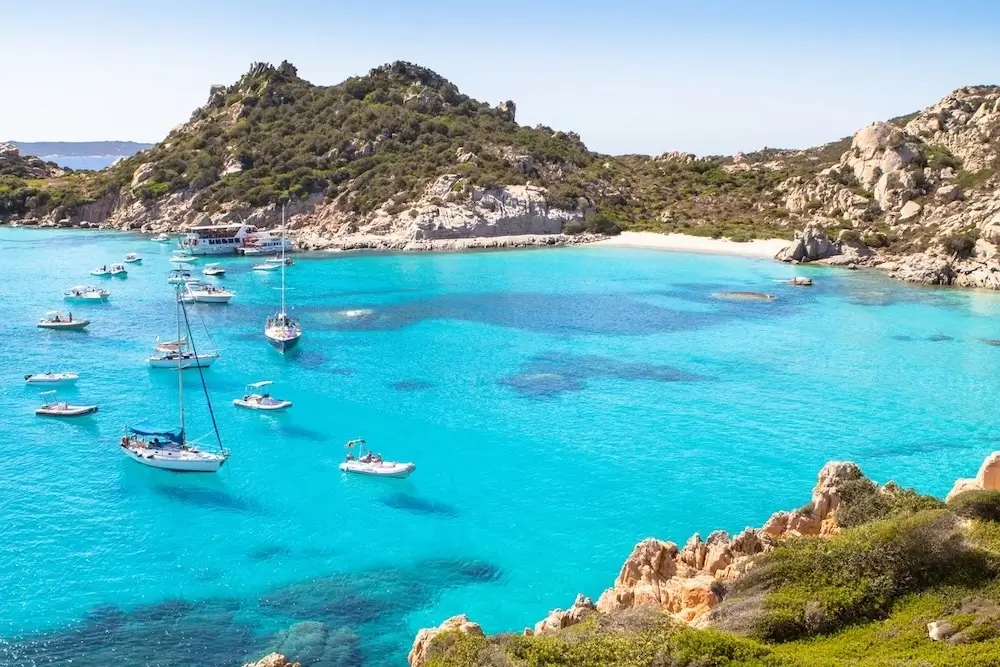
Sailing Vs. Motor Yachts
Considerations for sailing yachts: Experience level and desired level of involvement
When deciding between a sailing yacht and a motor yacht for your vacation, it is important to consider your experience level and desired level of involvement. Sailing yachts provide a unique and immersive experience, allowing you to harness the power of the wind and navigate the waters using your sailing skills. This option is perfect for those with a background in sailing or those who are eager to learn and be actively involved in the sailing process. On the other hand, motor yachts offer a more relaxed and effortless experience, with the ability to cover longer distances in a shorter amount of time. If you prefer a vacation where you can sit back, relax, and enjoy the scenery, a motor yacht may be the right choice for you. Ultimately, the decision between a sailing yacht and a motor yacht depends on your personal preferences and the type of vacation experience you are seeking.
Considerations for motor yachts: Speed, convenience, and comfort
When choosing a yacht for your vacation, it’s important to consider the specific benefits of a motor yacht. Motor yachts offer the advantage of speed, allowing you to cover larger distances in a shorter amount of time and explore multiple destinations in a single trip. Additionally, motor yachts provide unparalleled convenience, as they are equipped with powerful engines that eliminate the need for sails and can easily navigate through various weather conditions. Moreover, motor yachts prioritize comfort, offering spacious interiors, luxurious amenities, and smooth cruising experiences. Whether you’re looking for a thrilling adventure or a relaxing getaway, a motor yacht is the perfect choice to ensure a memorable and enjoyable vacation.
Destinations: Which type of yacht is better suited for different locations?
When it comes to choosing the right type of yacht for your vacation, considering the destination is key. Sailing yachts are ideal for exploring picturesque coastal areas, where the wind can carry you to hidden coves and remote islands. Their ability to navigate shallow waters makes them perfect for destinations like the Caribbean or the Mediterranean. On the other hand, motor yachts are better suited for longer distances and open waters, allowing you to cover more ground and reach destinations like the Bahamas or the Greek Islands in a shorter amount of time. Ultimately, your choice will depend on the specific location you plan to visit, ensuring that you can fully enjoy the beauty and uniqueness of each destination.
Cost comparison: Factors to consider when budgeting for a sailing or motor yacht vacation
When budgeting for a sailing or motor yacht vacation , there are several factors to consider that can impact the overall cost. While sailing yachts may initially seem more affordable due to lower fuel costs, it’s important to take into account other expenses such as maintenance, mooring fees, and crew salaries. On the other hand, motor yachts may have higher fuel costs, but they often offer more luxurious amenities and faster travel times. Additionally, the size of the yacht and the number of guests can also affect the price, with larger yachts generally being more expensive. By carefully considering these factors, you can determine whether a sailing or motor yacht vacation is the right choice for your budget and preferences.
Crew or no crew: Deciding whether to hire a crew or captain your own yacht
Deciding whether to hire a crew or captain your own yacht is a crucial factor in determining the type of experience you want during your vacation. While both options have their advantages, choosing the right one depends on your preferences, sailing skills, and desired level of relaxation. Hiring a crew allows you to sit back and enjoy your vacation without worrying about navigation, maintenance, or cooking. It also provides an opportunity to learn from experienced professionals and explore new destinations with ease. On the other hand, captaining your own yacht offers a sense of independence and adventure. You have the freedom to explore at your own pace and make spontaneous decisions. However, it requires a certain level of sailing expertise and the ability to handle various responsibilities. Ultimately, weighing the pros and cons of each option will help you make an informed decision and ensure a memorable yacht vacation tailored to your needs.
Personal preferences: Factors to consider based on your individual preferences and priorities
When deciding between sailing and motor yachts for your vacation, it’s important to consider your personal preferences and priorities. Sailing yachts offer a unique experience, allowing you to harness the power of the wind and embrace a slower pace of travel. This can be perfect for those looking for a more immersive and tranquil experience on the water. On the other hand, motor yachts offer speed and convenience, allowing you to easily explore multiple destinations in a shorter amount of time. If you value flexibility and the ability to cover more ground, a motor yacht may be the better choice for you. Ultimately, the decision comes down to what you prioritize in a vacation and the type of experience you want to have on the water.
Conclusion: Making the right choice for your dream yacht vacation
After weighing the pros and cons of sailing and motor yachts , it is crucial to make the right choice for your dream yacht vacation. Sailing yachts offer a sense of adventure and the opportunity to harness the power of the wind, providing a unique and eco-friendly experience. On the other hand, motor yachts offer speed, comfort, and the convenience of reaching your destination quickly. Factors such as your sailing experience, desired itinerary, and personal preferences should be considered when making this decision. Whether you prefer the thrill of sailing or the luxury of a motor yacht, choosing the right vessel will ensure that your yacht vacation is nothing short of extraordinary.
About the Author: Europe Yachts Charter
Related Posts
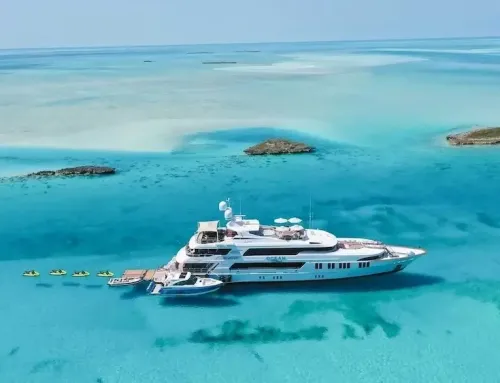
Why are Croatia and Greece popular yacht charter destinations in Europe?

What is the best time to charter a yacht in Croatia and Greece?
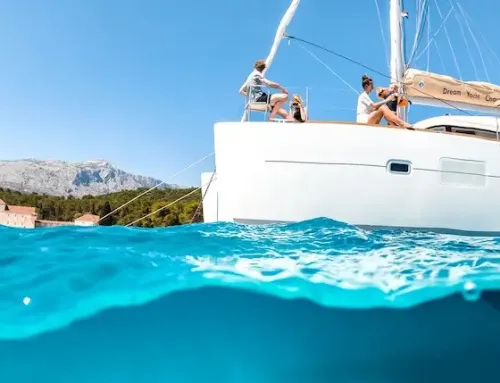
How to Rent Yacht Charter Without Problems
Real Time Availability
Secure Booking Service
No Cost Reservation

CUSTOMER CARE
Blog Book Now Contact us
EUROPE NETWORK
Catamaran Charter Croatia Catamaran Charter Greece Catamaran Charter Italy Catamaran Charter BVI
CHECK BOATS

SECURE PAYMENTS HANDLED BY

CONTACT CENTER
Croatia Split: +385 21 55 33 01 +385 21 55 33 09 +385 91 3000 009
Croatia Zagreb: +385 1 67 00 501 +385 1 67 00 509
USA: +1 646 661 2851 United Kingdom: +44 203 318 2329

You make the memories. We make the arrangements.
Motor Yacht or Sailing Yacht?
Chartering a luxury yacht is the ultimate way to experience a truly personalized vacation. While...
Chartering a luxury yacht is the ultimate way to experience a truly personalized vacation. While the destination is of utmost importance, the yacht you choose is equally significant. With so many yacht styles, sizes and amenities, it can be hard to keep things straight. Especially for first-time yachters. To help you understand the differences between luxury motor yacht charters vs. sailing yacht charters, we’ve put together a quick guide.
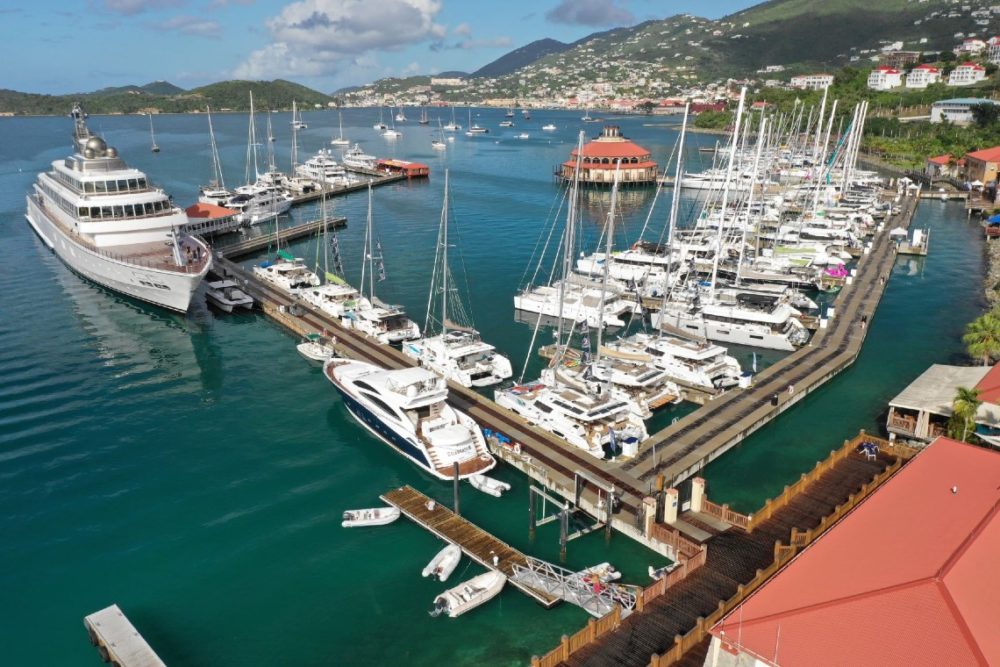
Motor Yachts
Super-yachts & mega-yachts.
The highly capable motor yacht can take you on Arctic expeditions, luxurious trips along the Italian Riviera , or snorkeling in the Bahamas. No matter the conditions outside, motor yachts deliver comfort, style, and plenty of room to unwind. Motor yachts are a luxury resort at sea, with many featuring gyms, pools, theaters, and more. Some even have helipads for effortlessly accessing even the most remote locations.
Large families or group vacations among friends can be easily accommodated on super-yachts (78ft+/24m) and megayachts (200ft+/60m). Numerous staterooms and flexible sleeping configurations allow for private spaces and many group gathering areas. Smaller yachts from 40ft+/12m are also great options for smaller groups or couples celebrating their honeymoon.
If you’re into water toys, many motor yachts carry numerous tenders from jet skis, to kiteboards, paddleboards, inflatables, and scuba equipment. Additionally, dedicated crew can be requested for instructing and accompanying guests on many water excursions. With the flexibility that comes with a motor yacht, some guests can choose to go fishing, while others can take the tender to shore for some beach time.
Speed is also a great attribute of motor yachts. You can experience more destinations in a shorter time with the power of 40+ knots, and no reliance on the wind. Their sheer size and advanced stabilizers also allow for smooth sailing while underway. Take a look at the luxurious accommodations aboard Superyacht Starship .
Motor Catamarans
Flexible, comfortable, and perfect for cruising shallow waters. That’s one way to describe the increasingly popular motor catamaran category. These yachts combine the agility of a smaller boat, with many of the conveniences of a large motor yacht. The dual hulls also allow for a more stable ride while underway. Lack of sails provides a lower clearance for added flexibility in lower passages.
Smaller than most megayachts, catamarans can still typically accommodate groups of up to 12 and offer two or three levels of area for relaxing and dining. Many modern yachts even feature forward cockpit areas for secluded outdoor space in the front of the boat. Couples can easily share these boats without problems. While families can have their space spreading out on the flybridge as well as the main deck.
Motor Catamarans can also cruise at a quick clip, reaching 22-25 knots, depending on the boat and conditions. This allows for easy navigation of groups of islands like the USVI , Bahamas, Greece, and more. You can also get much closer to land in these gorgeous lagoon areas and tiny ports.
Water sports enthusiasts will appreciate the easy access to the water that catamarans boast. Drop anchor and swim, snorkel, or go kayaking within minutes. Most catamarans also carry dinghies or tenders to explore or tow inflatables.
Onboard, the galley and salon are prioritized with wide and easily traversed configurations perfect for gourmet dinners. Front deck areas often feature trampolines for relaxing and breezy sunbathing. What completes the package is the low fuel consumption that comes with the small engines and lighter-weight frames. Catamarans provide the option to enjoy a private yacht charter more economically.
Sailing Yachts
Sailing catamaran.
Like the aforementioned power catamarans, the sailing catamaran yachts offer a very comfortable experience, suited for many top yachting locations around the world. They traverse these gorgeous waters, however, at a slower pace, reaching 9-10 knots per hour, depending on conditions and the boat’s engine. This is an important factor to consider when choosing between a motor yacht vs. sailing yacht.
Those in search of true relaxation will appreciate the quiet sailing of these luxury sailing catamarans, a major difference from luxury motor yachts. In addition, sailing enthusiasts can learn techniques and lend a helping hand to the crew if so desired.
Nearly all of the great designs of a power catamaran also exist aboard sail yachts. Flybridges and front cockpits allow for more distinct lounging and sightseeing vistas. As with power catamarans, the water is easily accessed, giving way to hours of water sports enjoyment.
Gliding through the water with two hulls, these sailing catamarans navigate the seas more flatly than traditional mono-hull sailboats, also adding comfort and stability. Also important, sailing catamarans can travel long distances without the need for refueling. Not to mention the lower fuel costs and the smaller environmental footprint this amounts to. A factor to note when choosing between a motor yacht vs. sailing yacht.
A sailboat yacht charter offers guests a truly unique and exciting experience. Most notably, you have the great opportunity to learn sailing terminology, equipment, and maneuvers. You’ll be able to participate in the journey while gaining expert knowledge from the seasoned crew.
In addition, you’ll love the quiet experience and thrill of being propelled by the wind, just as explorers have been doing for millennia. Activities like fishing, swimming, snorkeling are easily reached from the boat.
Larger toys like jet skis or motorized equipment are however not as readily available. The shape of sailing yachts does limit some storage, typically found on powerboats. However, the captain and crew will do their best to accommodate all guests’ preferences and desires.
Traditional sailboat yachts can reach lengths of 220 ft, enabling large groups to charter in total comfort. The large decks, some with flybridges flow elegantly into interior salons. The staterooms also offer great space and amenities for entertainment and dining.
Utilizing the wind for as much travel as possible, sail yachts can travel further distances without the need for stopping to refuel. In some cases, sailboats are the only way to reach very remote islands and blue water attractions. This of course also means very low fuel consumption in comparison to power yachts.
We hope this helps you in choosing between chartering a luxury motor yacht vs. sailing yacht. Please visit our wide array of luxury yachts for charter and let us plan your dream trip today!
Similar Posts
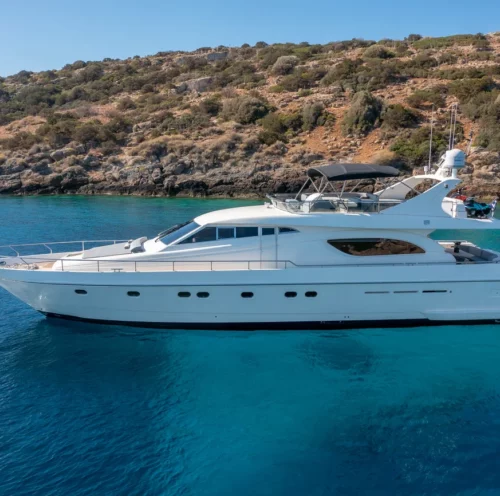
Kottero Exclusive Yachting | Divine Short-Term Charters
We’re featuring Kottero Exclusive Yachting, one of the Greek Charter Brokerage Companies we utilize for...
Read Kottero Exclusive Yachting | Divine Short-Term Charters

Off-Season Yacht Charter in Greece | 5 Reasons to Visit
Exploring Greece is an adventure, especially when doing so on the deck of a luxury...
Read Off-Season Yacht Charter in Greece | 5 Reasons to Visit

Luxury Yacht Shipping Company | A1 Auto Transport
Who is A1 Auto Transport? They are a Luxury Yacht Shipping Company that ships vehicles,...
Read Luxury Yacht Shipping Company | A1 Auto Transport
Let us deliver on your dream vacation.
Contact us to start a conversation about your dream vacation, and let us show you how we can help bring your vision to life through our exceptional yacht charter services.
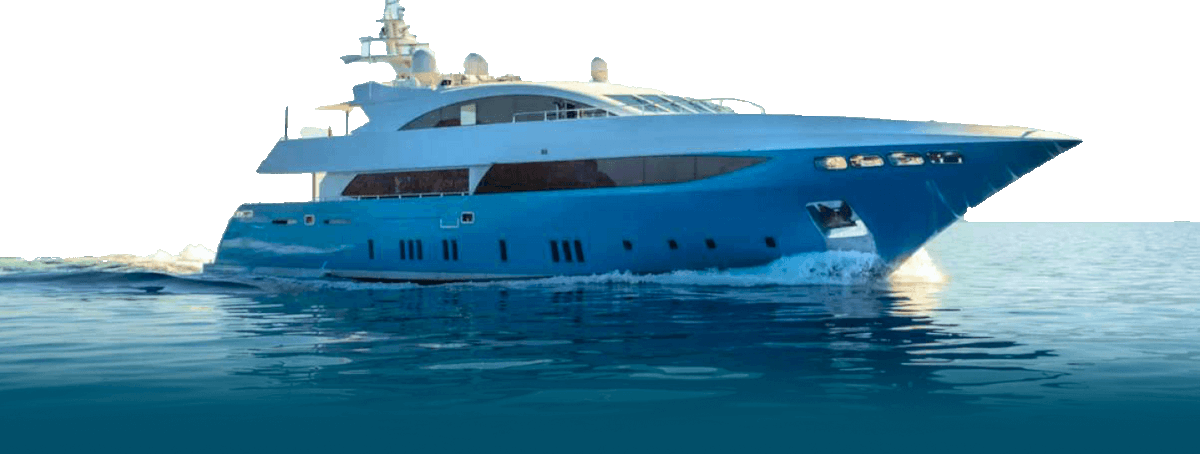

- (954) 633-4878
- [email protected]
Compass Articles
- December 1, 2023
What Are the Differences Between a Motor Yacht and a Sailing Yacht? – Fly Yachts Explains
Embarking on the quest for the perfect yacht is a voyage in itself, one filled with visions of slicing through cerulean waves, sun-drenched lounging, and starry nights at anchor. At the crux of this quest lies a fundamental decision point: Do you set your sights on the technological prowess of a motor yacht or the romanticism of a sailing yacht? Fly Yachts, with its deep-rooted expertise in the yachting domain, delves into the quintessential differences between these two maritime marvels, assisting seafarers in charting a course to their ideal yachting experience.

The Quintessence of Yachting: Power Versus Romance
The heart of motor yachts: performance and luxury unleashed.
Motor yachts are often viewed as the epitome of luxury at sea, showcasing:
- Speed and Agility: Motor yachts are engineered for performance, cutting through the water with ease and reaching destinations swiftly.
- Voluminous Space: With generous beam widths and multi-deck designs, these vessels offer expansive living areas, lavish staterooms, and ample entertainment spaces.
- Ease of Handling: Often equipped with the latest in navigation and propulsion technologies, modern motor yachts simplify piloting to a surprising degree.
Amenities and Features Tailored for the Elite
Owners of motor yachts are usually treated to a wide range of high-end amenities such as onboard theaters, gourmet kitchens, Jacuzzis, and even helipads. The customizations are virtually limitless, reflecting the personalized needs of the affluent mariner.
The Spirit of Sailing Yachts: Harmony with the Elements
Conversely, sailing yachts offer a distinct allure, characterized by:
- The Art of Sailing: Captains of sailing yachts engage with the craft, attuning themselves to the wind and waves for propulsion—a deeply rewarding and skillful endeavor.
- Environmental Synergy: Sailing yachts epitomize the eco-friendly journey, predominantly powered by the natural elements and leaving a minimal carbon footprint.
- Timeless Aesthetics: The ballet of sails against the sky is an image that captures the essence of nautical tradition, appealing to those who seek an aesthetic connection with seafaring history.

A Sustainable and Sensory Journey
Sailing yachts provide an intimate experience with the ocean, inviting sailors to work in concert with nature. This traditional mode of yachting is often seen as more sustainable and explorative, with the quietness of sail power offering a serene escape.
Design Philosophies: Innovation Meets Tradition
Customized craftsmanship in motor yachts.
The construction and design of motor yachts are a testament to human ingenuity, incorporating the latest breakthroughs in marine construction:
- Advanced Materials: Innovative use of carbon fiber, Kevlar, and other composites reduce weight while improving strength and stability.
- Hydrodynamic Efficiency: Design emphasis is often placed on hull shapes that are optimized for a smooth and fast ride across the water’s surface.
Sailing Yachts: Nautical Heritage Refined
Sailing yachts, while also benefiting from modern materials, pay homage to the art of shipbuilding, with handcrafted woodwork and intricate rigging systems reflecting a rich legacy that spans centuries.
- Rig Design: Developments in sail materials and rig configurations afford sailing yachts better control and reduced labor to harness the wind efficiently.
- Keel Innovation: Modern keel designs enhance stability and speed, making sailing yachts more maneuverable and capable.
Defining Journeys: The Voyage Itself as the Destination

Exploring the World with Motor Yachts
Motor yacht enthusiasts often delight in the ability to cover large distances quickly, making it possible to explore multiple destinations in a condensed timeframe. The robust nature of these yachts means they can face diverse weather conditions with confidence.
The Sailing Yacht: Embracing the Ocean’s Rhythm
Sailing purists argue that the slower pace of a yacht under sail provides a more immersive experience, fostering a deeper connection with the sea. Voyages become as much about the journey as the destination, as sailors embrace the rhythm of the ocean and the nuances of the wind.
Partnering with Experts: Fly Yachts’ Tailored Guidance
The personal touch in selecting your ideal yacht.
Fly Yachts appreciates that choosing between a motor yacht and a sailing yacht is an intensely personal decision. This choice is not just about aesthetics or utility; it reflects an individual’s philosophy and approach to life at sea.
Crafting Your Exceptional Maritime Narrative with Fly Yachts
Whether your heart leans toward the potent allure of motorized luxury or the elemental dance of a sailing yacht, Fly Yachts is dedicated to refining and realizing your vision. Speak to a Fly Yachts team member today to explore the vessels that resonate with your spirit and begin charting your own legendary maritime narrative.
In the discourse of power versus sail, Fly Yachts is your concierge to the sea—guiding, equipping, and empowering you to select a yacht that is not just a means to an end, but the very essence of your oceanic odyssey.

Fly Yachts’ Frequently Asked Questions
What are the primary differences between a motor yacht and a sailing yacht.
Motor yachts are powered mainly by engines and tend to offer more space and luxury amenities, while sailing yachts harness wind power and emphasize the experience and skill of sailing.
How does the performance of motor yachts compare to sailing yachts?
Motor yachts typically provide faster and more stable cruising on open water. Sailing yachts offer a quieter, more environmentally friendly experience and require knowledge of wind patterns and sail handling.
Are there differences in maintenance between motor and sailing yachts?
Yes, motor yachts often require more mechanical maintenance related to their engines, while sailing yachts necessitate regular sail and rigging inspections and maintenance.
Does the cost of ownership differ between motor and sailing yachts?
Generally, motor yachts incur higher fuel and maintenance costs. Sailing yachts tend to be less expensive to operate but may have higher costs associated with rigging and sail care.
What should I consider when choosing between a motor yacht and a sailing yacht?
Consider your boating experience, lifestyle preferences, intended use, and budget. Your choice will also be influenced by whether you prefer the thrill of sailing or the comfort and power of a motor yacht.
How do the onboard amenities typically differ between motor and sailing yachts?
Motor yachts often have more luxurious amenities due to larger interior spaces, including full-sized kitchens, multiple cabins, and entertainment areas. Sailing yachts may have more modest amenities due to space constraints.
Is there a difference in the learning curve when operating motor versus sailing yachts?
Yes, sailing yachts require learning the art of sailing, which can be more complex due to the dependence on wind and mastering various sails. Operating a motor yacht can be more straightforward, focusing on piloting and navigation.
What are the environmental impacts of motor yachts versus sailing yachts?
Sailing yachts are generally more environmentally friendly due to their reliance on wind power. Motor yachts, especially those not using eco-friendly technology, can have a larger carbon footprint due to fuel consumption.
Can both motor yachts and sailing yachts be used for long-distance cruising?
Both types of yachts can handle long-distance cruising, but the choice depends on the preferred style of voyage, potential fuel stops for motor yachts, and the sailor’s ability to manage the vessel in various conditions.
How does Fly Yachts help clients decide between a motor yacht and a sailing yacht?
Fly Yachts provides expert guidance, discussing your needs and preferences, and offering tailored recommendations to ensure you choose the right type of yacht for your lifestyle and cruising goals.
Step into the world of maritime elegance with Fly Yachts, where prospective buyers can find an exquisite fleet of seafaring crafts on their Yachts for Sale page. A quick look at the Homepage presents a broad overview of Fly Yachts’ commitment to quality and customer satisfaction in yachting services. More about their seasoned expertise and unique approach to yacht brokerage is available on the About Us page. Those looking to create a personalized nautical masterpiece can explore the Build a Yacht section for custom design options. The Charter Destinations page is a treasure map for adventurers seeking to explore some of the most breathtaking charter locations around the globe. Gain valuable insights with the easily digestible and informative content available on the Compass Articles page, perfect for yachting enthusiasts. Yacht owners considering a sale can find expert advice and services tailored to their needs through the Sell Your Yacht feature. Vacationers and sea lovers looking to book a luxury experience on the water should browse the Yachts Charter page for a selection of charters. Additionally, the Aircraft for Sale page caters to those with a penchant for aerial luxury, offering upscale aircraft listings. Stay up-to-date with the latest yachting news and trends on the Gulfstream News page. Should you have any questions or need assistance, the Contact page provides the details to get in touch with Fly Yachts’ helpful and knowledgeable team.
About FLY Yachts
Unmatched Industry Knowledge, Paired With Brokers Who Care Equals Yachting You Love.
Recent Posts

The Quintessential Yacht Purchase: A Pathway to Living in Luxury

Yacht Ownership Uncovered: Buying Tips for the Worldly Elite
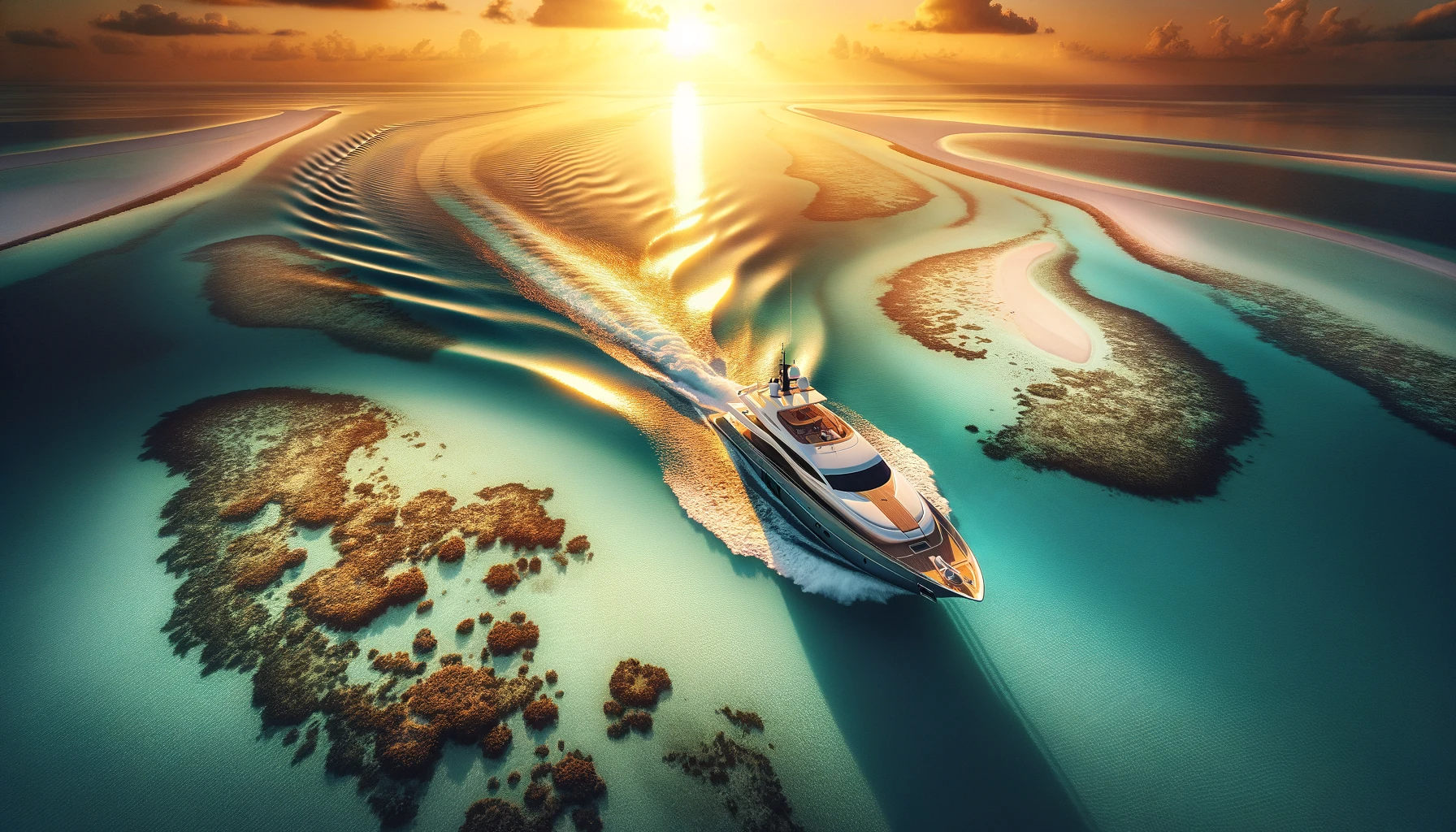
Luxury Yacht Buying: How to Realize Your Aspirations of Opulence

- English (UK)
- English (AU)
- English (US)
- Lietuviškai
- Slovenščina
Travel Itineraries
Sailing destinations.
- Tips from us
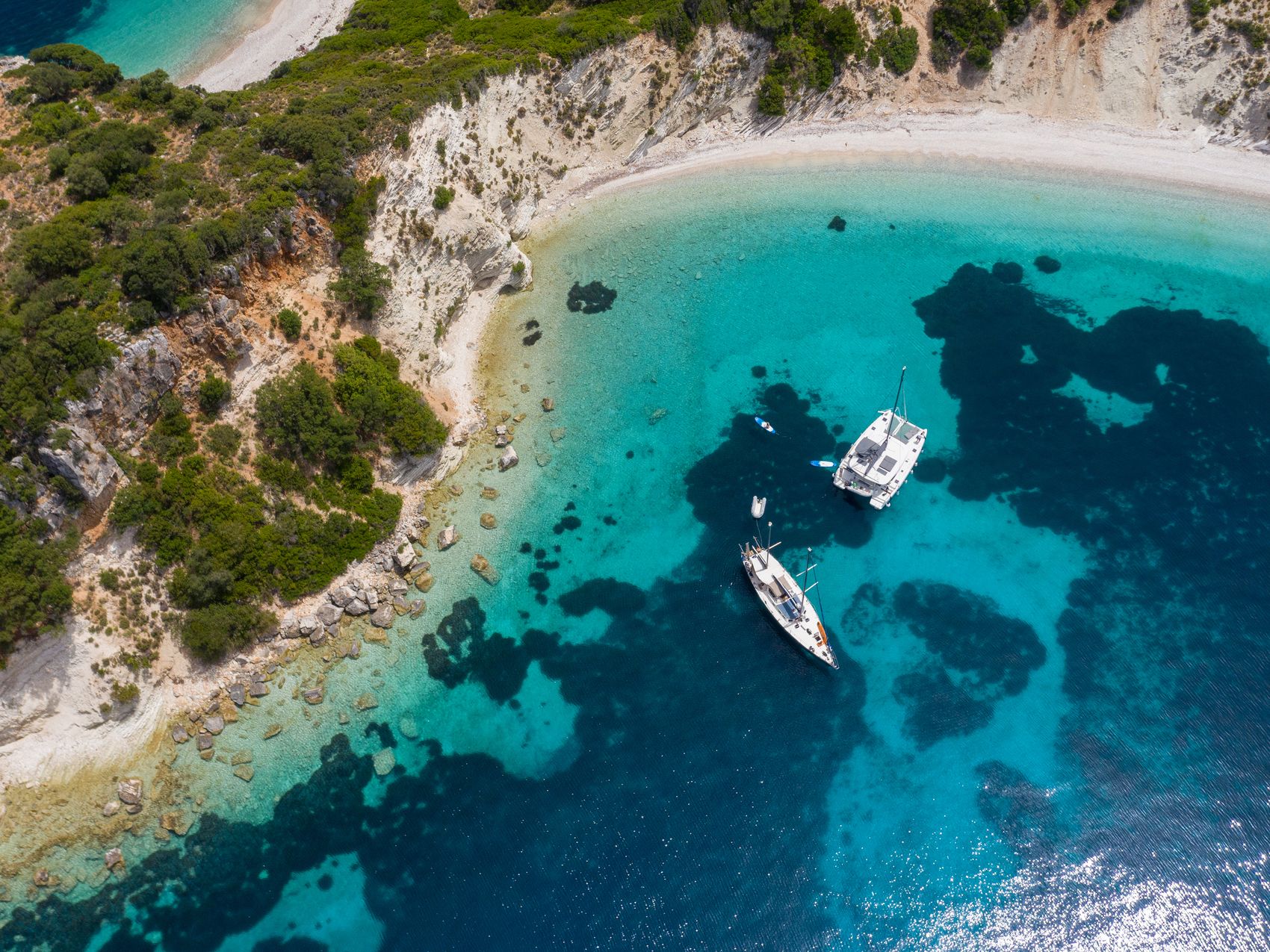
- Catamaran vs. Sailboat – Which one to choose?
A frequently discussed topic among sailors is what type of boat to choose for the next adventure. Should you go for a classic sailing yacht, catamaran or motorboat? Which boat is better? Each vessel can provide you with an unforgettable experience. It is impossible to say that a catamaran is better than a sailboat and vice versa. The question is, rather, what do you want, what are your needs, abilities and budget
Proponents of monohulls love the typical wobbliness of these boats and the authentic sailing experience that they convey. On the contrary, fans of catamarans praise their luxurious spaciousness and stability. Both teams are right.
Let’s take a closer look at the differences between monohulls - such as sailboats and multihull boats - such as catamarans . For a better comparison, we will focus only on boats with sails. There are also multi-hull motor boats (power catamarans), three-hull boats (trimarans), or single-hull motor yachts and boats. Let’s compare charter sailboats and catamarans based on their handling, equipment, comfort, safety in different conditions and routes, and, last but not least, the price.
What is the difference between a sailing yacht and a catamaran?
Let's start with the basics. Sailing yachts are typically monohulls that are propelled by sails and have a single keel that runs along the bottom of the hull.
Discover the latest review of the Bavaria 46, one of the most popular sailboats
Catamarans have two hulls that are connected by a bridge. Catamarans are generally wider, more stable, and more spacious than sailing yachts, making them a popular choice among families and groups of friends looking for recreational boats.
Discover the latest review of the Lagoon 450F, one of the most popular catamarans
Handling and manoeuvring.
The catamaran consists of two hulls, twin engines and two rudders. Sails are similar to those on the sailboat. Due to a short keel, the catamaran has a shallow draft. The construction of the catamaran makes it move faster and, above all, with better stability than a monohull vessel. The experience of real sailing on a catamaran is impoverished by typical heeling and swaying. The catamaran will neither rock you from side to side nor tilt as it happens on a sailboat. But some crews can consider this as their big advantage. On the other hand, sometimes a catamaran has a tendency to slap on the water.
On the other hand, the sailboat has a long keel and a triangular shape, thanks to which it slices through the water with less effort. The typical movement of the ship is rocking and heeling.
The speed of both vessels also depends on the direction of the wind. When sailing downwind , catamarans usually achieve greater speed than sailboats. Sailboats, on the other hand, perform better when sailing upwind . During turns, sailboats are better manoeuvrable and respond to a helm better, while catamarans lose the necessary impulse for a prompt turn faster.
Unlike a sailboat, a catamaran is practically unsinkable . However, from a physics point of view, it is easier to capsize a catamaran, although the probability of this happening is relatively low, and the boat stays afloat, providing a haven for the crew.
The limit of positive stability (or angle of vanishing stability), which can make the boat capsize, is considerably smaller in the case of a catamaran than in the case of a sailboat. A catamaran is not able to self-right. A strong gust of wind or a wave can tilt the sailboat over when heeled to a more than 90-degree angle (the keel of the boat protrudes above the surface), and it can still be able to return to its normal position by itself. Therefore, a sailboat works more smoothly in waves than a catamaran. However, large and breaking waves are equally dangerous for both types of boats, and you must sail perpendicular to the direction of the waves in such conditions.
Docking and anchoring
Although a catamaran may seem more difficult to park at first glance due to its more massive appearance, the parking manoeuvre is surprisingly easier than with sailboats. You are able to turn the catamaran 360 degrees on the spot. This is not possible to perform with a sailboat. The catamaran is equipped with two engines that can be controlled independently. The disadvantage of the catamaran’s robustness is that it often takes up 1.5 - 2 times more space in the marina than a similarly long sailboat. Especially in peak season, finding a place to dock can be difficult.
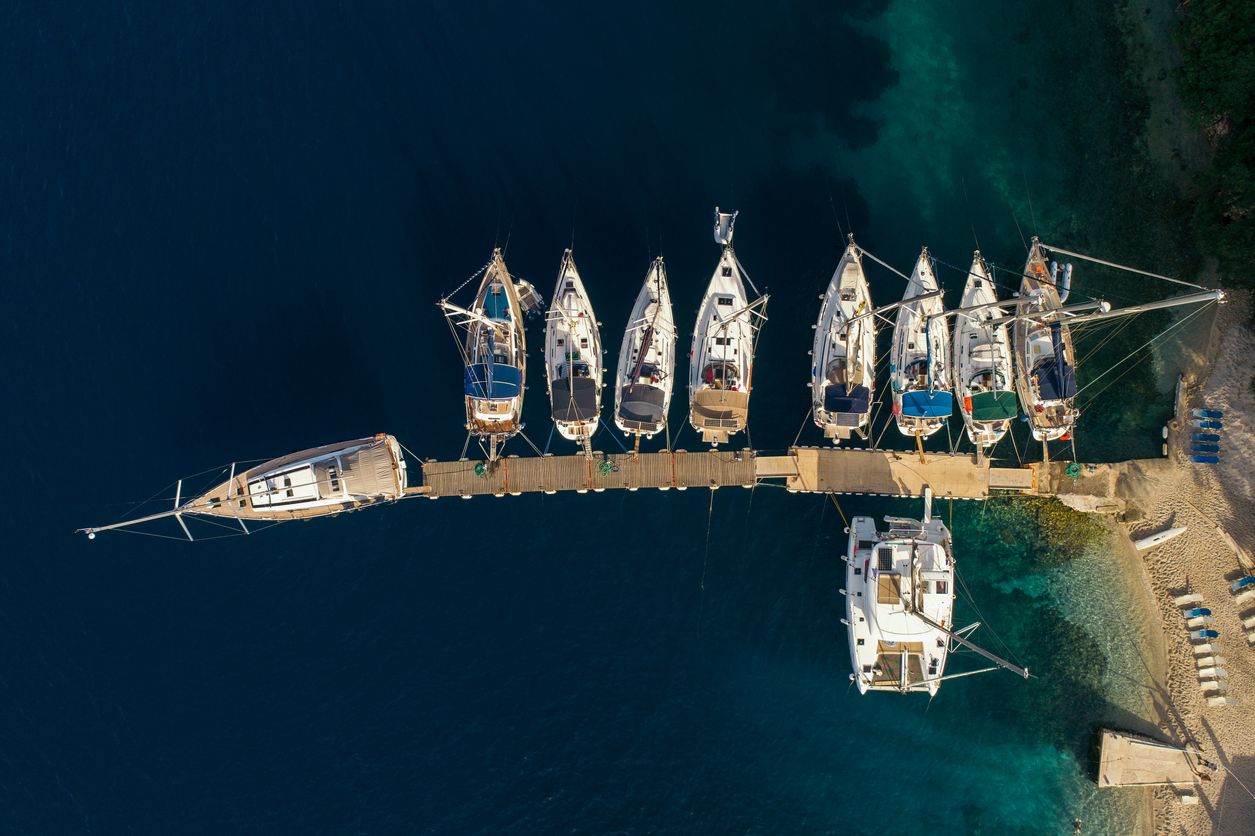
On the contrary, anchoring a catamaran can seem more complicated, at least at the beginning. If you are chartering a catamaran for the first time, be sure to inquire about the anchoring system when taking over the boat. When anchoring the catamaran, you need a bridle rope with a carabiner, which you tie to both the bows and the anchor chain in the middle. The anchor is then centred and the position of the rope prevents damage to the hulls from the chain.
The indisputable advantage of anchoring with a catamaran is its low draft. The absence of a very long keel allows you to drop the anchor even in shallow bays and closer to the shore, where you would not be able to stay with a sailboat.
A catamaran is definitely more comfortable . Both for the captain and the crew. It is more spacious and calmer during sailing. If you have a crew that often suffers from seasickness, such members usually feel better on the catamaran. Take in mind that a catamaran has its specific movements as well, and they may not suit everyone’s stomach either. Under the same conditions, you can chase mugs in the kitchen and wipe up spilt coffee on a sailboat, and on a catamaran, you can at most "complain" about boredom during the cruise.
During a gust of waves, the crew on the sailboat gets wet immediately; on the catamaran, you can hide and stay dry. Even such a detail as staying dry can uplift the crew’s mood during adverse weather conditions.
Catamarans are more often equipped with automatic winches. You don’t work so hard manually as you do on a sailboat. Working with the sails is also less demanding, and you have clear instructions for reefing the sails with regular charter catamarans.

You will appreciate the catamaran more on hot summer days. Air circulation is much better on catamarans. The view from inside the boat is more beautiful from the catamaran because the living part of the deck of the catamaran is located above the water level. You won’t see much from the saloon in the sailboat. As for the view of the ship itself, most sailors enjoy the sight of elegant and well built, agile sailboats more than of multihull "bulldozers" on the water.
Safety depends not so much on the type of vessel as on other factors - the age and state of the ship, the weather and the human element. If we talk about the safety of staying and moving on the boat itself, a catamaran is definitely a safer place for children and the elderly.
In extreme conditions, a monohull is more wobbly on the water and often a bit safer because a sailboat can take care of itself. It can "dance" in big waves more smoothly and independently than a catamaran. The captain needs clear correction and control in strong winds and high waves.
It is true that if you capsize a sailboat , it has the ability to self-right. When you capsize a catamaran, only the towing service will help you. However, once you’re in a situation where even your sailboat almost capsizes, chances are you’re already in huge trouble anyway.
Do catamarans flip easily?
The largest modern catamarans exhibit impressive buoyancy and outstanding resistance to rolling. This ensures that capsizes or inversions are unlikely to occur. When faced with 30-foot breaking waves, the boat gracefully sways from side to side.
You can enjoy long routes in greater comfort and with a longer period of self-sufficiency on catamarans. These are usually equipped with solar panels for electricity production, desalinators for obtaining drinking water and generous storage space.
A catamaran is more expensive than a sailboat of similar size. In addition, you will pay extra for parking fees in marinas and city piers, for entering national parks and sometimes for fuel. The price often wins as a decisive argument when choosing a charter boat. Although the price difference may not be negligible, a catamaran’s additional benefits (higher comfort, stability and spaciousness) often compensate for the higher price.
An example of a comparison of rental fleet prices: renting a catamaran Lagoon 42 from 2019 with a length of about 13 meters (6 cabins) will cost you about 480 euros per day; alternatively, renting a sailboat Jeanneau Sun Oddysey from 2019 with a length of about 13 meters (5 cabins) and with a bow thruster can cost from 200 euros per day. The price may vary depending on the month and discounts from the charter company.
How much does a sailboat cost?
Sailboat prices are different, but it is possible to get some idea of the price if we study markets and use several examples. The cost of cruising boats is usually €250,000 or less. The price of a new boat typically ranges between €100,000 and €1,000,000. The value of a used sailboat varies based on its size and year of manufacture, usually between €10,000 and €100,000.

If you long for a real experience of authentic sailing, you want to enjoy the heel and feel the wind in your hair, then a sailboat is an obvious choice. A sailboat will also be a better option if you plan to reach less accessible, narrow, and capacity-limited places where maneuvering a large catamaran could be problematic. A sailing yacht won’t hurt your wallet as much as a catamaran.
If you don’t like the adrenaline rush of sport sailing, you prefer bigger living space, and especially if you have children on board, you will fall in love with a catamaran. When choosing a catamaran over a sailboat, enthusiasts of diving and other water activities that require storing bulky items will also be grateful.
If you don’t want to lose the charm of yachting while sailing on a sailboat, but you are worried about the wobbly movement tendencies, for instance, while docking in a marina, choose a sailboat equipped with a bow thruster for easier maneuvering.
What type of boat is better for a novice captain?
We recommend building practice first on a classic sailing yacht (monohull) for novice captains. You need to get enough feel for maneuvering the ship as such. A robust, comfortable, and stable catamaran will forgive many mistakes under normal conditions. Even a novice crew can be trained better on a sailboat - a catamaran "spoils" the crew more quickly.
An old sailor’s proverb says, “a smooth sea never made a skilled sailor” . So, if you are still at the beginning of your captain’s journey, a similar rule also applies when choosing a vessel :)
So, what is the best deal for your next yacht charter vacation? Whether a catamaran or a sailboat, a multihull or a monohull is better, there is no winner or a loser. Each vessel has different advantages and disadvantages. Very important aspects of life on a boat are a good captain, a friendly and capable crew and favorable conditions for sailing. Although we cannot guarantee this at Boataround, we are here for you when choosing a specific boat.
At the end of the day, the choice is yours:

How to Choose the Ideal Yacht for Your Sailing Adventure
You might wonder why anyone would need help choosing between a sailing yacht and a power yacht. It’s easy, you might say: it depends on the kind of person you are. If you want to be involved in the actual experience, choose a sailing yacht. If you’re more interested in getting that tan, choose a power yacht. Yes… and no. The truth is, with strides in yacht technology and design, some lines between both have become blurred. This is just what we wish to do with this article today: sharpen the differences between both and highlight what makes each yacht type unique and memorable. So the next time you charter a yacht, you pick the one which best suits your sailing holiday expectancies.

Journey vs. Destination
In all fairness, we might have chosen the most difficult of differences to start off with. Reason being that, while this might have been relevant in the past, both a power yacht and a sailing yacht today offer enough commodities to be able to enjoy both the destination and the time it takes to get there. Traditionally, however, since a power yacht is by definition a more powerful vessel, it should be your preferred choice if you’re interested in getting to your destination as quickly as possible. With a sailing yacht, you can take your sweet time, relying on just the wind to carry you forward. So if time is of no consequence, you might wish to give the sailing yacht a thought.
Comfort vs. Intimacy
There is no denying the fact that a power yacht will be bigger and therefore more comfortable. The cabins are larger and the deck is ideally designed to entertain larger groups. A sailing boat is more constrained in this regard, with smaller cabins (though some of the larger sailing yachts really challenge this statement) and a more intimate deck area. It makes it ideal for families and close friends, though it could offer challenges if you’re trying to avoid your aunt who is constantly bemoaning her darling Coco (the annoying Chihuahua) who got left behind. To each his own.
Involvement vs. Detachment
While many holiday-goers will charter a yacht so they can relax and fully detach from having any kind of responsibilities, others look forward to really getting their hands dirty. If you’re all for sipping cocktails and flipping through your latest read while the sun slowly turns your skin to a divine bronze, then it’s safe to assume that a power yacht will be your best bet. If you really want to participate in getting your yacht to its destination, then a sailing yacht will satisfy your sailor-cravings best. Just make sure you discuss this when chartering your yacht.
The type of yacht you choose will be largely dictated by the type of holiday you’re looking to have. There is obviously no right or wrong in this – it all boils down to preferences. Make sure you know what you’re in for when you choose either of the two: if you’re the type to tire of a novelty early on, you might find that a sailing boat will test your patience a few days in. If on the other hand, you think happiness is in the journey and not the destination, then you might find that a power yacht speeds through at a faster rate than you’d care to enjoy. Think of it this way: the yacht is in many ways a reflection of yourself. When you come to deciding moment, charter the yacht which speaks to your moods most.

Book2Sail™ © 2024 All Rights Reserved - Book2Sail and the Book2Sail logo are registered trademarks of SAS Marine Services Ltd. in Malta
Guide to Understanding Sail Rig Types (with Pictures)
There are a lot of different sail rig types and it can be difficult to remember what's what. So I've come up with a system. Let me explain it in this article.
What are the different types of sail rig? The sail rig is determined by the number of masts and the layout and shape of sails. Most modern ships are fore-and-aft rigged, while old ships are square-rigged. Rigs with one mast are sloops and cutters. Ketches, yawls, brigs, and schooners have two masts. Barques have three masts. Rigs can contain up to seven masts.
'Yeah, that's a gaff brig, and that a Bermuda cutter' - If you don't know what this means (neither did I) and want to know what to call a two-masted ship with a square-rigged mainsail, this article is definitely for you.
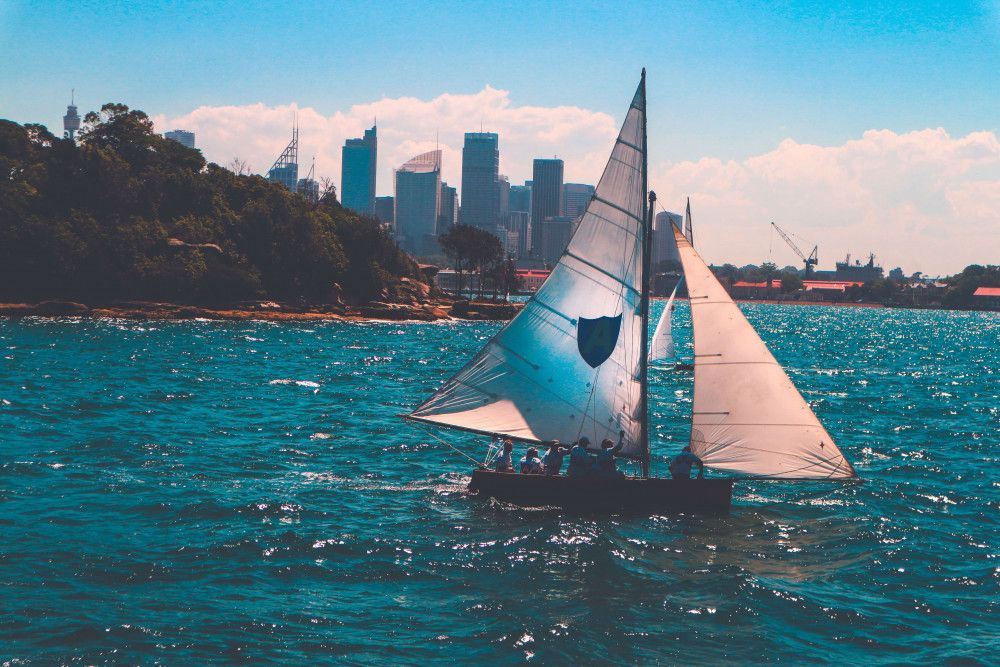
On this page:
More info on sail rig types, mast configurations and rig types, rigs with one mast, rigs with two masts, rigs with three masts, related questions.
This article is part 2 of my series on sails and rig types. Part 1 is all about the different types of sails. If you want to know everything there is to know about sails once and for all, I really recommend you read it. It gives a good overview of sail types and is easy to understand.
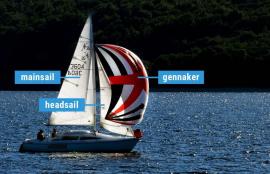
The Ultimate Guide to Sail Types and Rigs (with Pictures)
First of all, what is a sail rig? A sail rig is the way in which the sails are attached to the mast(s). In other words, it's the setup or configuration of the sailboat. The rig consists of the sail and mast hardware. The sail rig and sail type are both part of the sail plan. We usually use the sail rig type to refer to the type of boat.
Let's start by taking a look at the most commonly used modern sail rigs. Don't worry if you don't exactly understand what's going on. At the end of this article, you'll understand everything about rig types.
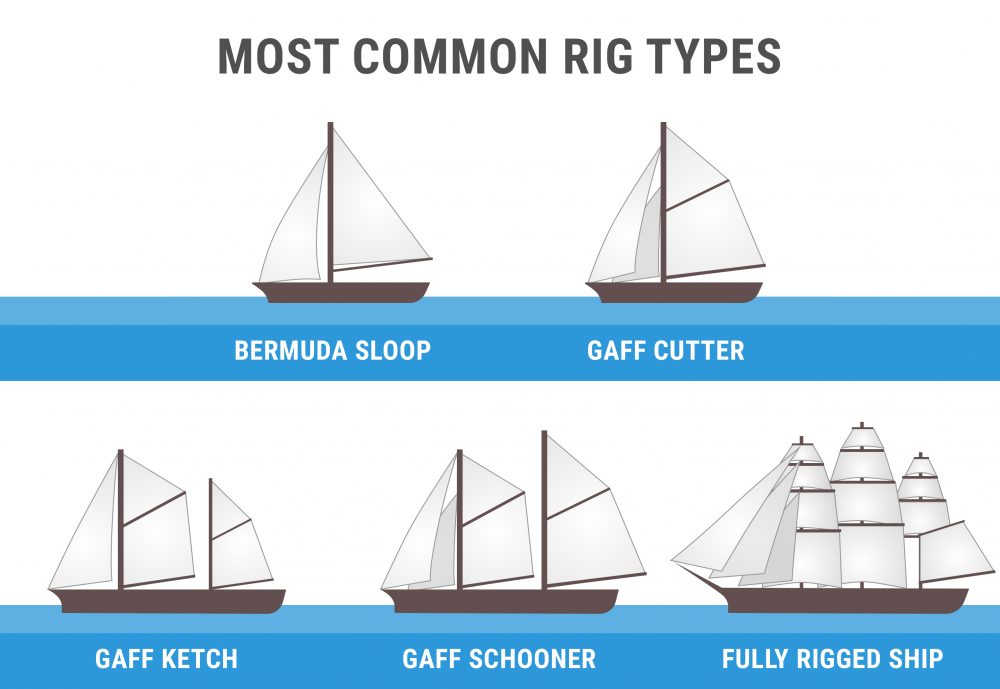
The sail rig and sail plan are often used interchangeably. When we talk of the sail rig we usually mean the sail plan . Although they are not quite the same. A sail plan is the set of drawings by the naval architect that shows the different combinations of sails and how they are set up for different weather conditions. For example a light air sail plan, storm sail plan, and the working sail plan (which is used most of the time).
So let's take a look at the three things that make up the sail plan.
The 3 things that make up the sail plan
I want to do a quick recap of my previous article. A sail plan is made up of:
- Mast configuration - refers to the number of masts and where they are placed
- Sail type - refers to the sail shape and functionality
- Rig type - refers to the way these sails are set up on your boat
I'll explore the most common rig types in detail later in this post. I've also added pictures to learn to recognize them more easily. ( Click here to skip to the section with pictures ).
How to recognize the sail plan?
So how do you know what kind of boat you're dealing with? If you want to determine what the rig type of a boat is, you need to look at these three things:
- Check the number of masts, and how they are set up.
- You look at the type of sails used (the shape of the sails, how many there are, and what functionality they have).
- And you have to determine the rig type, which means the way the sails are set up.
Below I'll explain each of these factors in more detail.
The most common rig types on sailboats
To give you an idea of the most-used sail rigs, I'll quickly summarize some sail plans below and mention the three things that make up their sail plan.
- Bermuda sloop - one mast, one mainsail, one headsail, fore-and-aft rigged
- Gaff cutter - one mast, one mainsail, two staysails, fore-and-aft rigged
- Gaff schooner - two-masted (foremast), two mainsails, staysails, fore-and-aft rigged
- Gaff ketch - two-masted (mizzen), two mainsails, staysails, fore-and-aft rigged
- Full-rigged ship or tall ship - three or more masts, mainsail on each mast, staysails, square-rigged
The first word is the shape and rigging of the mainsail. So this is the way the sail is attached to the mast. I'll go into this later on. The second word refers to the mast setup and amount of sails used.
Most sailboats are Bermuda sloops. Gaff-rigged sails are mostly found on older, classic boats. Square-rigged sails are generally not used anymore.
But first I want to discuss the three factors that make up the sail plan in more detail.
Ways to rig sails
There are basically two ways to rig sails:
- From side to side, called Square-rigged sails - the classic pirate sails
- From front to back, called Fore-and-aft rigged sails - the modern sail rig
Almost all boats are fore-and-aft rigged nowadays.
Square sails are good for running downwind, but they're pretty useless when you're on an upwind tack. These sails were used on Viking longships, for example. Their boats were quicker downwind than the boats with fore-and-aft rigged sails, but they didn't handle as well.
The Arabs first used fore-and-aft rigged sails, making them quicker in difficult wind conditions.
Quick recap from part 1: the reason most boats are fore-and-aft rigged today is the increased maneuverability of this configuration. A square-rigged ship is only good for downwind runs, but a fore-and-aft rigged ship can sail close to the wind, using the lift to move forward.
The way the sails are attached to the mast determines the shape of the sail. The square-rigged sails are always attached the same way to the mast. The fore-and-aft rig, however, has a lot of variations.
The three main sail rigs are:
- Bermuda rig - most used - has a three-sided (triangular) mainsail
- Gaff rig - has a four-sided mainsail, the head of the mainsail is guided by a gaff
- Lateen rig - has a three-sided (triangular) mainsail on a long yard
The Bermuda is the most used, the gaff is a bit old-fashioned, and the lateen rig is outdated (about a thousand years). Lateen rigs were used by the Moors. The Bermuda rig is actually based on the Lateen rig (the Dutch got inspired by the Moors).

Other rig types that are not very common anymore are:
- Junk rig - has horizontal battens to control the sail
- Settee rig - Lateen with the front corner cut off
- Crabclaw rig
Mast configuration
Okay, we know the shape of the mainsail. Now it's time to take a look at the mast configuration. The first thing is the number of masts:
- one-masted boats
- two-masted boats
- three-masted boats
- four masts or up
- full or ship-rigged boats - also called 'ships' or 'tall ships'
I've briefly mentioned the one and two mast configurations in part 1 of this article. In this part, I'll also go over the three-masted configurations, and the tall ships as well.
A boat with one mast has a straightforward configuration because there's just one mast. You can choose to carry more sails or less, but that's about it.
A boat with two masts or more gets interesting. When you add a mast, it means you have to decide where to put the extra mast: in front, or in back of the mainmast. You can also choose whether or not the extra mast will carry an extra mainsail. The placement and size of the extra mast are important in determining what kind of boat we're dealing with. So you start by locating the largest mast, which is always the mainmast.
From front to back: the first mast is called the foremast. The middle mast is called the mainmast. And the rear mast is called the mizzenmast.

What is the mizzenmast? The mizzenmast is the aft-most (rear) mast on a sailboat with three or more masts or the mast behind the mainmast on a boat with two masts. The mizzenmast carries the mizzen sail. On a two-masted boat, the mizzenmast is always (slightly) smaller than the mainmast. What is the purpose of the mizzen sail? The mizzen sail provides more sail area and flexibility in sail plan. It can be used as a big wind rudder, helping the sailor to have more control over the stern of the ship. It pushes the stern away from the wind and forces the bow in the opposite way. This may help to bring the bow into the wind when at anchor.
I always look at the number of masts first, because this is the easiest to spot. So to make this stuff more easy to understand, I've divided up the rig types based on the number of masts below.
Why would you want more masts and sail anyways?
Good question. The biggest advantage of two masts compared to one (let's say a ketch compared to a sloop), is that it allows you to use multiple smaller sails to get the same sail area. It also allows for shorter masts.
This means you reduce the stress on the rigging and the masts, which makes the ketch rig safer and less prone to wear and tear. It also doesn't capsize as quickly. So there are a couple of real advantages of a ketch rig over a sloop rig.
In the case of one mast, we look at the number of sails it carries.
Boats with one mast can have either one sail, two sails, or three or more sails.
Most single-masted boats are sloops, which means one mast with two sails (mainsail + headsail). The extra sail increases maneuverability. The mainsail gives you control over the stern, while the headsail gives you control over the bow.
Sailor tip: you steer a boat using its sails, not using its rudder.
The one-masted rigs are:
- Cat - one mast, one sail
- Sloop - one mast, two sails
- Cutter - one mast, three or more sails
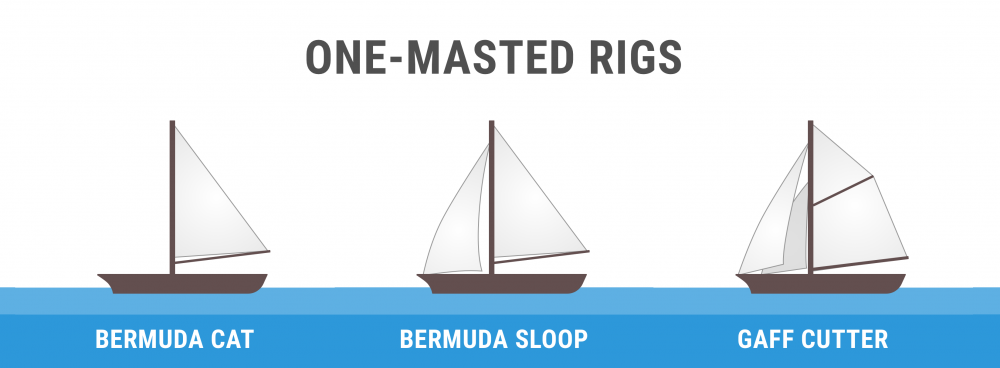
The cat is the simplest sail plan and has one mast with one sail. It's easy to handle alone, so it's very popular as a fishing boat. Most (very) small sailboats are catboats, like the Sunfish, and many Laser varieties. But it has a limited sail area and doesn't give you the control and options you have with more sails.
The most common sail plan is the sloop. It has one mast and two sails: the main and headsail. Most sloops have a Bermuda mainsail. It's one of the best racing rigs because it's able to sail very close to the wind (also called 'weatherly'). It's one of the fastest rig types for upwind sailing.
It's a simple sail plan that allows for high performance, and you can sail it short-handed. That's why most sailboats you see today are (Bermuda) sloops.
This rig is also called the Marconi rig, and it was developed by a Dutch Bermudian (or a Bermudian Dutchman) - someone from Holland who lived on Bermuda.
A cutter has three or more sails. Usually, the sail plan looks a lot like the sloop, but it has three headsails instead of one. Naval cutters can carry up to 6 sails.
Cutters have larger sail area, so they are better in light air. The partition of the sail area into more smaller sails give you more control in heavier winds as well. Cutters are considered better for bluewater sailing than sloops (although sloops will do fine also). But the additional sails just give you a bit more to play with.
Two-masted boats can have an extra mast in front or behind the mainmast. If the extra mast is behind (aft of) the mainmast, it's called a mizzenmast . If it's in front of the mainmast, it's called a foremast .
If you look at a boat with two masts and it has a foremast, it's most likely either a schooner or a brig. It's easy to recognize a foremast: the foremast is smaller than the aft mast.
If the aft mast is smaller than the front mast, it is a sail plan with a mizzenmast. That means the extra mast has been placed at the back of the boat. In this case, the front mast isn't the foremast, but the mainmast. Boats with two masts that have a mizzenmast are most likely a yawl or ketch.
The two-masted rigs are:
- Lugger - two masts (mizzen), with lugsail (a cross between gaff rig and lateen rig) on both masts
- Yawl - two masts (mizzen), fore-and-aft rigged on both masts. Main mast is much taller than mizzen. Mizzen without a mainsail.
- Ketch - two masts (mizzen), fore-and-aft rigged on both masts. Main mast with only slightly smaller mizzen. Mizzen has mainsail.
- Schooner - two masts (foremast), generally gaff rig on both masts. Main mast with only slightly smaller foremast. Sometimes build with three masts, up to seven in the age of sail.
- Bilander - two masts (foremast). Has a lateen-rigged mainsail and square-rigged sails on the foremast and topsails.
- Brig - two masts (foremast), partially square-rigged. The main mast carries small lateen-rigged sail.

The yawl has two masts that are fore-and-aft rigged and a mizzenmast. The mizzenmast is much shorter than the mainmast, and it doesn't carry a mainsail. The mizzenmast is located aft of the rudder and is mainly used to increase helm balance.
A ketch has two masts that are fore-and-aft rigged. The extra mast is a mizzenmast. It's nearly as tall as the mainmast and carries a mainsail. Usually, the mainsails of the ketch are gaff-rigged, but there are Bermuda-rigged ketches too. The mizzenmast is located in front of the rudder instead of aft, as on the yawl.
The function of the ketch's mizzen sail is different from that of the yawl. It's actually used to drive the boat forward, and the mizzen sail, together with the headsail, are sufficient to sail the ketch. The mizzen sail on a yawl can't really drive the boat forward.
Schooners have two masts that are fore-and-aft rigged. The extra mast is a foremast which is generally smaller than the mainmast, but it does carry a mainsail. Schooners are also built with a lot more masts, up to seven (not anymore). The schooner's mainsails are generally gaff-rigged.
The schooner is easy to sail but not very fast. It handles easier than a sloop, except for upwind, and it's only because of better technology that sloops are now more popular than the schooner.
The brig has two masts. The foremast is always square-rigged. The mainmast can be square-rigged or is partially square-rigged. Some brigs carry a lateen mainsail on the mainmast, with square-rigged topsails.
Some variations on the brig are:
Brigantine - two masts (foremast), partially square-rigged. Mainmast carries no square-rigged mainsail.
Hermaphrodite brig - also called half brig or schooner brig. Has two masts (foremast), partially square-rigged. Mainmast carries a gaff rig mainsail and topsail, making it half schooner.
Three-masted boats are mostly barques or schooners. Sometimes sail plans with two masts are used with more masts.
The three-masted rigs are:
- Barque - three masts, fore, and mainmast are square-rigged, the mizzenmast is usually gaff-rigged. All masts carry mainsail.
- Barquentine - three masts, foremast is square-rigged, the main and mizzenmast are fore-and-aft rigged. Also called the schooner barque.
- Polacca - three masts, foremast is square-rigged, the main and mizzenmast are lateen-rigged.
- Xebec - three masts, all masts are lateen-rigged.

A barque has three or four masts. The fore and mainmast are square-rigged, and the mizzen fore-and-aft, usually gaff-rigged. Carries a mainsail on each mast, but the mainsail shape differs per mast (square or gaff). Barques were built with up to five masts. Four-masted barques were quite common.
Barques were a good alternative to full-rigged ships because they require a lot fewer sailors. But they were also slower. Very popular rig for ocean crossings, so a great rig for merchants who travel long distances and don't want 30 - 50 sailors to run their ship.
Barquentine
The barquentine usually has three masts. The foremast is square-rigged and the main and mizzenmast fore-and-aft. The rear masts are usually gaff-rigged.
Faster than a barque or a schooner, but the performance is worse than both.
The polacca or polacre rig has three masts with a square-rigged foremast. The main and mizzenmast are lateen-rigged. Beautiful boat to see. Polacca literally means 'Polish' (it's Italian). It was a popular rig type in the Mediterranean in the 17th century. It looks like the xebec, which has three lateen-rigged masts.
Fun fact: polaccas were used by a Dutch sailor-turned-Turkish-pirate (called Murat Reis).
The xebec is a Mediterranean trading ship with three masts. All masts are lateen-rigged. I couldn't find any surviving xebecs, only models and paintings. So I guess this rig is outdated a long time.
A boat with three or more masts that all carry square-rigged sails is called a ship, a tall ship, or a full-rigged ship. So it's at this point that we start calling boats 'ships'. It has nothing to do with size but with the type of rigging.
More sails mean less stress on all of them. These ships use a lot of sails to distribute the forces, which reduces the stress on the rigging and the masts. Square sails mean double the sail area in comparison to triangular sails.
They are quite fast for their size, and they could outrun most sloops and schooners (schooners were relatively a lot heavier). The reason is that tall ships could be a lot longer than sloops, giving them a lot of extra hull speed. Sloops couldn't be as large because there weren't strong enough materials available. Try making a single triangular sail with a sail area of over 500 sq. ft. from linen.
So a lot of smaller sails made sense. You could have a large ship with a good maximum hull speed, without your sails ripping apart with every gust of wind.
But you need A LOT of sailors to sail a tall ship: about 30 sailors in total to ie. reef down sails and operate the ship. That's really a lot.
Tall ships are used nowadays for racing, with the popular tall ship races traveling the world. Every four years I go and check them out when they are at Harlingen (which is very close to where I live).
Check out the amazing ships in this video of the tall ship races last year near my hometown. (The event was organized by friends of mine).
What is the difference between a schooner and a sloop? A schooner has two masts, whereas the sloop only has one. The schooner carries more sails, with a mainsail on both masts. Also, sloops are usually Bermuda-rigged, whereas schooners are usually gaff-rigged. Most schooners also carry one or two additional headsails, in contrast to the single jib of the sloop.
What do you call a two-masted sailboat? A two-masted sailboat is most likely a yawl, ketch, schooner, or brig. To determine which one it is you have to locate the mainmast (the tallest). At the rear: schooner or brig. In front: yawl or ketch. Brigs have a square-rigged foremast, schooners don't. Ketches carry a mainsail on the rear mast; yawls don't.
What is a sloop rig? A sloop rig is a sailboat with one mast and two sails: a mainsail and headsail. It's a simple sail plan that handles well and offers good upwind performance. The sloop rig can be sailed shorthanded and is able to sail very close to the wind, making it very popular. Most recreational sailboats use a sloop rig.
What is the difference between a ketch and a yawl? The most important difference between a ketch and a yawl are the position and height of the mizzenmast. The mizzenmast on a yawl is located aft of the rudder, is shorter than the mainmast and doesn't carry a mainsail. On a ketch, it's nearly as long as the mainmast and carries a mainsail.

There are a wonderful lots of DIY changeability shows on the cable airwaves these days.
Rick the rigger
There are SO many errors on this site it really should be taken down.
First major mistake is to say you are no longer afraid of the sea.
One that truly gets up my nose is the term ‘fully’ rigged ship. It’s a FULL rigged ship!! Your mast names are the wrong way round and just because there may be 3 it doesn’t automatically mean the one in the middle is the main.
I could go on and totally destroy your over inflated but fragile ego but I won’t. All I will say is go learn a lot more before posting.
Shawn Buckles
Thanks for your feedback. If you like to point out anything more specific, please let me know and I will update the articles. I’ve changed fully-rigged to full-rigged ship - which is a typo on my part. I try to be as concise as I can, but, obviously, we all make mistakes every now and then. The great thing about the internet is that we can learn from each other and update our knowledge together.
If you want to write yourself and share your knowledge, please consider applying as a writer for my blog by clicking on the top banner.
Thanks, Shawn
Well, I feel that I’ve learned a bit from this. The information is clear and well laid out. Is it accurate? I can’t see anything at odds with the little I knew before, except that I understood a xebec has a square rigged centre mainmast, such as the Pelican ( https://www.adventureundersail.com/ )
Hi, Shawn, You forgot (failed) to mention another type of rig? The oldest type of rig known and still functions today JUNK RIG!
Why are so many of the comments here negative. I think it is wonderful to share knowledge and learn together. I knew a little about the subject (I’m an Aubrey-Maturin fan!) but still found this clarified some things for me. I can’t comment therefore on the accuracy of the article, but it seems clear to me that the spirit of the author is positive. We owe you some more bonhomme I suggest Shawn.
As they say in the Navy: “BZ” - for a good article.
Been reading S.M. Stirling and wanted to understand the ship types he references. Thank you, very helpful.
This site is an awesome starting point for anyone who would like to get an overview of the subject. I am gratefull to Shawn for sharing - Thanks & Kudos to you! If the negative reviewers want to get a deeper technical knowledge that is accurate to the n-th then go study the appropriate material. Contribute rather than destroy another’s good work. Well done Shawn. Great job!
Good stuff Shawn - very helpful. As a novice, it’s too confusing to figure out in bits and pieces. Thanks for laying it out.
First of all I have to say that Rick ‘the rigger’ is obviously the one with the “over inflated but fragile ego” and I laughed when you suggested he share his knowledge on your blog, well played!
As for the content it’s great, hope to read more soon!
Alec Lowenthal
Shawn, I have a painting of a Spanish vessel, two masted, with. Lateen sails on both masts and a jib. The mainsail is ahead of the main mast (fore) and the other is aft of the mizzen mast. Would this be what you call lugger rig? I have not seen a similar picture. Thanks, Alec.
Thank you for your article I found easy to read and understand, and more importantly remember, which emphasises the well written.. Pity about the negative comments, but love your proactive responses!
This vessel, “SEBASTIAN” out of Garrucha, Almería, España, was painted by Gustave Gillman in 1899.
Sorry, picture not accepted!
Thank you for a very informative article. I sail a bit and am always looking for more knowledge. I like the way you put forth your info and I feel if you can’t say anything positive, then that person should have their own blog or keep their opinions to their-self. I will be looking for more from you. I salute your way of dealing with negative comments.
Thank you for a great intro to sailing boats! I searched different sailboats because I use old sails tp make bags and wanted to learn the difference. Way more than I ever expected. Thanks for all the work put in to teach the rest of us.
Your description of a cutter is lacking, and your illustrations of “cutters” are actually cutter-rigged sloops. On a true cutter, the mast is moved further aft (with more than 40% of the ship forward of the mast). A sloop uses tension in the backstay to tension the luff of the foresail. The cutter can’t do this.
Also, a bermuda-rigged ketch will have a line running from the top of the mainmast to the top of the mizzenmast.
wow great guide to rig types! thanks
Interesting guide, however I am confused about the description of the brig. You say the main mast on a brig can have a lateen sail, but in your picture it looks like a gaff sail to me. How is it a lateen sail?
Hi Shawn, thank you for taking the time to share this information. It is clear and very helpful. I am new to sailing and thinking of buying my own blue water yacht. The information you have supplied is very useful. I still am seeking more information on performance and safety. Please keep up the good work. Best Regards
mickey fanelli
I’m starting to repair a model sailboat used in the lake I have three masts that have long been broken off and the sails need replacement. So my question is there a special relationship between the three masts I do have reminents of where the masts should go. they all broke off the boat along with the sails I can figure out where they go because of the old glue marks but it makes no sense. or does it really matter on a model thank you mickey
Cool, total novice here. I have learnt a lot. Thanks for sharing - the diagrams along with the text make it really easy to understand, especially for a beginner who hasn’t even stepped on a sailing boat.
Daryl Beatt
Thank you. Cleared up quite a few things for me. For example, I was familiar with the names “Xebecs” and “Polaccas” from recent reading about the Barbary War. I had gathered that the two Barbary types were better suited to sailing in the Med, but perhaps they were less able to be adaptable to military uses,(but one might assume that would be ok if one plans to board and fight, as opposed to fight a running gun duel). Specifically, the strangely one sided August 1, 1801 battle between the USS Enterprise under Lt. John Sterett and the Polacca cruiser Tripoli under Admiral Rais Mahomet Rous. On paper both ships seemed nearly equal in size, guns and crew, but pictures of the battle are confusing. While the Enterprise is usually rendered as the familiar schooner, the polacca Tripoli has been pictured in radically different ways. Thus the Wikipedia picture by Hoff in 1878 used to illustrate the Battle shows a Brig design for Tripoli, indicating 77 years later, polaccas were no longer common.
Lee Christiansen
I am curious as to what you would call a modern race boat with a fractional jib,not equipped for full masthead hoist? Thanks Lee
Thanks Guy: The information and pictures really eliminate a lot of the mystery of the terminology and the meanings. Also appreciate the insight of the handling idiosyncrasies “hand” (staff) requirements to manage a vessel for one that has not been on the water much. I long to spend significant time afloat, but have concern about the ability to handle a vessel due to advancing age. The Significant Other prefers to sit (in AC comfort)and be entertained by parties of cruise line employees. Thanks again for the information.
Gordon Smith
Your discussion made no mention of the galleon, a vessel with either square-rigged Fore and Main masts and a shorter lateen-rigged Mizzen, or, on larger galleons, square-rigged Fore and Main masts, with a lateen-rigged Mizzen and a lateen-rigged Bonaventure mast, both shorter than either the Fore or Main masts. Also, it was not uncommon for a galleon to hoist a square-rigged bowsprit topsail in addition to the usual square-rigged spritsail.
Emma Delaney
As a hobbyist, I was hesitant to invest in expensive CAD software, but CADHOBBY IntelliCAD has proven to be a cost-effective alternative that delivers the same quality and performance.
https://www.cadhobby.com/
Leave a comment
You may also like.
What's that sail for? Generally, I don't know. So I've come up with a system. I'll explain you everything there is to know about sails and rigs in this article.

17 Sailboat Types Explained: How To Recognize Them

Different Types of Sailing and Racing Explained

How Are Sail Numbers Assigned? (And how to pick yours)
Own your first boat within a year on any budget.
A sailboat doesn't have to be expensive if you know what you're doing. If you want to learn how to make your sailing dream reality within a year, leave your email and I'll send you free updates . I don't like spam - I will only send helpful content.
Ready to Own Your First Boat?
Just tell us the best email address to send your tips to:

IMAGES
VIDEO
COMMENTS
A yacht may require, at the very least, another pair of eyes. 4. Whether or not there is a sail. This difference is purely aesthetic for the most part. Whether or not there is a sail. A sailboat, unsurprisingly, will always have a sail. The nail is how the boat harnesses the wind and what drives it forward.
Sailing Yacht vs Sailboat. The terms "sailing yacht" and "sailboat" are often used interchangeably, but there are some nuanced differences. While all sailing yachts are sailboats, not all sailboats are considered yachts as a yacht is classified as a vessel over 79ft. Sailing yachts are typically larger, more luxurious vessels, equipped ...
The maritime definition of a yacht is a private pleasure ship of at least 33 feet. At YachtWorld, we tend to consider anything in the 35-40-foot range (or larger) a yacht. Then again, different kinds of boats approach being that long, even some pontoon boats and walkarounds. However, an engine-powered watercraft under 30 feet is not usually ...
Size Matters. The size difference between a yacht and a sailboat is one of the most significant ones. Most of the time, a sailboat will almost certainly be smaller than a yacht. Of course, some sailboats are larger than others, but if we're talking about average sizes, a yacht will be larger.
Sailboat - A boat usually propelled by sail sailboat. Boat - A small vessel for travel on water. Yacht - Any of various recreational watercraft, such as a) a sailboat used for racing, or b) a large usually motor-driven craft used for pleasure cruising. Merriam-Webster Dictonary.
A yacht can be purchased as a sailing yacht or a power yacht but a sailboat is always going to rely on its sails for any long-distance voyage. Also, sailboats can be purchased in a wide variety of sizes. A sailing yacht is usually longer than 26'. As a result, a yacht might be harder to sail than a traditional sailboat. In fact, it may be ...
Another key difference between yacht and sailboat crews is the size of the vessel. Yachts are typically much larger than sailboats, which means that they require more crew members to operate efficiently. Sailboats, on the other hand, are typically much smaller and can be operated with a smaller crew.
However, since the total sail area is distributed between multiple smaller sails forces on the boat are more equally dispersed and can be controlled and manipulated easier. This sail design can be especially handy when sailing short-handed as it means that sail trim and reefing are easier. Multiple masts also effect the boat design.
With that said, the yacht vs. sailboat debate ultimately comes down to several distinguishing factors between the two. The main difference between yachts and sailboats is that sailboats have sails and yachts don't. Sailboats are also smaller than yachts, feature fewer amenities, and cannot move quite as fast. Yachts are also much more ...
A yacht up to 100 ft. long is considered a yacht, while a yacht over 100 ft. long is considered a mega-yacht or superyacht. Yachts and mega-yachts are powered by either sail or engines. Yachts powered by a motor in an engine are usually the most popular choice for large groups or families due to them having more space and stability.
It also refers to a tender to a bigger boat or yacht. "Ship" is a large commercial boat, often used for distance travel and transport of goods or passengers - cruise ship, container ship, etc. "Yacht" is typically a larger boat with luxury amenities used as a recreational vessel— motor yacht, sailing yacht. "Superyacht" is a ...
The most common kind of sailboat is the sloop, as it's simple to operate and versatile. Other common sailboat types include the schooner, cutter, cat, ketch, schooner, catamaran, and trimaran. Other sailboat variations include pocket cruisers, motorsailers, displacement, and shoal-draft vessels. The information found in this article is sourced ...
There are many nuances and subtle differences between water vessel types, but below are some of the main differences. In general, yachts are either sailing or motor vessels used for pleasure. Yachts are often luxurious and equipped with an overnight cabin. Boats can be either propelled sail or a motor and come in varying sizes.
Unlike sailing yachts, motor yachts are powered by engines, providing a faster and more efficient mode of transportation. This means you can cover greater distances in a shorter amount of time, allowing you to explore more destinations during your vacation. Additionally, motor yachts offer luxurious amenities and spacious interiors, making them ...
Romanticism and Authenticity vs Ease of Cruising. A sailing yacht caters more to the romantic notion of traditional yachtsmanship. With the feeling of the wind in your hair, salt spray on your face and sun on your skin offering a wonderfully liberating experience where unforgettable moments with family and friends are created, sailing is unquestionably a more thrilling and involved experience ...
This is an important factor to consider when choosing between a motor yacht vs. sailing yacht. Those in search of true relaxation will appreciate the quiet sailing of these luxury sailing catamarans, a major difference from luxury motor yachts. In addition, sailing enthusiasts can learn techniques and lend a helping hand to the crew if so desired.
Dive into the elegant nuances that distinguish motor yachts from their sailing counterparts, shaping your nautical journey. Our comprehensive breakdown emphasizes performance variations, design philosophies, and the unique ambience each yacht type presents to seafarers. Gain insight into the allure of mastery over the winds versus the power of engines, and how this choice reflects upon your ...
What is the difference between a sailing yacht and a catamaran? Let's start with the basics. Sailing yachts are typically monohulls that are propelled by sails and have a single keel that runs along the bottom of the hull. Discover the latest review of the Bavaria 46, one of the most popular sailboats ...
Comfort vs. Intimacy. There is no denying the fact that a power yacht will be bigger and therefore more comfortable. The cabins are larger and the deck is ideally designed to entertain larger groups. A sailing boat is more constrained in this regard, with smaller cabins (though some of the larger sailing yachts really challenge this statement ...
Different types of yachts include motor yachts, sailing yachts, and cruisers. This article explores the differences between these luxury, power and sailing boats and the advantages of yacht co-ownership. ... What is the difference between a superyacht and a yacht? What makes a superyacht a superyacht? Typically, yachts that are at least 80 feet ...
The 5 most common two-masted rigs are: Lugger - two masts (mizzen), with lugsail (cross between gaff rig and lateen rig) on both masts. Yawl - two masts (mizzen), fore-and-aft rigged on both masts. Main mast much taller than mizzen. Mizzen without mainsail. Ketch - two masts (mizzen), fore-and-aft rigged on both masts.
The two-masted rigs are: Lugger - two masts (mizzen), with lugsail (a cross between gaff rig and lateen rig) on both masts. Yawl - two masts (mizzen), fore-and-aft rigged on both masts. Main mast is much taller than mizzen. Mizzen without a mainsail. Ketch - two masts (mizzen), fore-and-aft rigged on both masts.